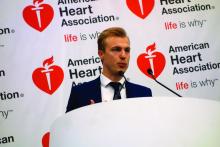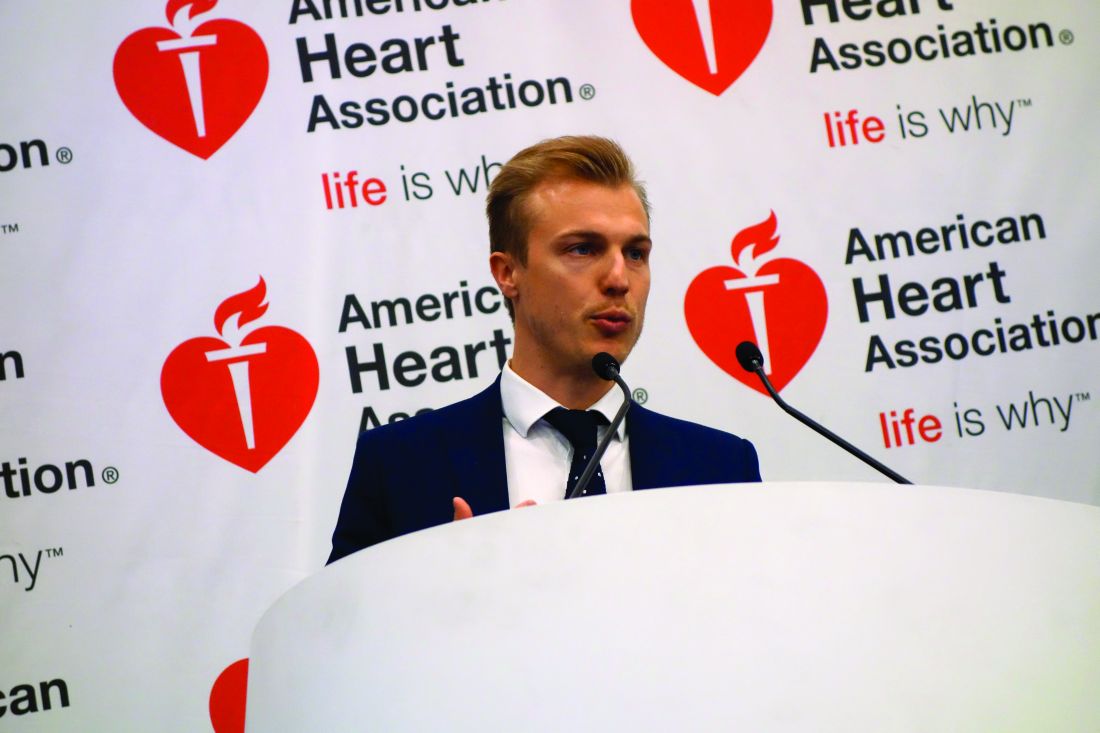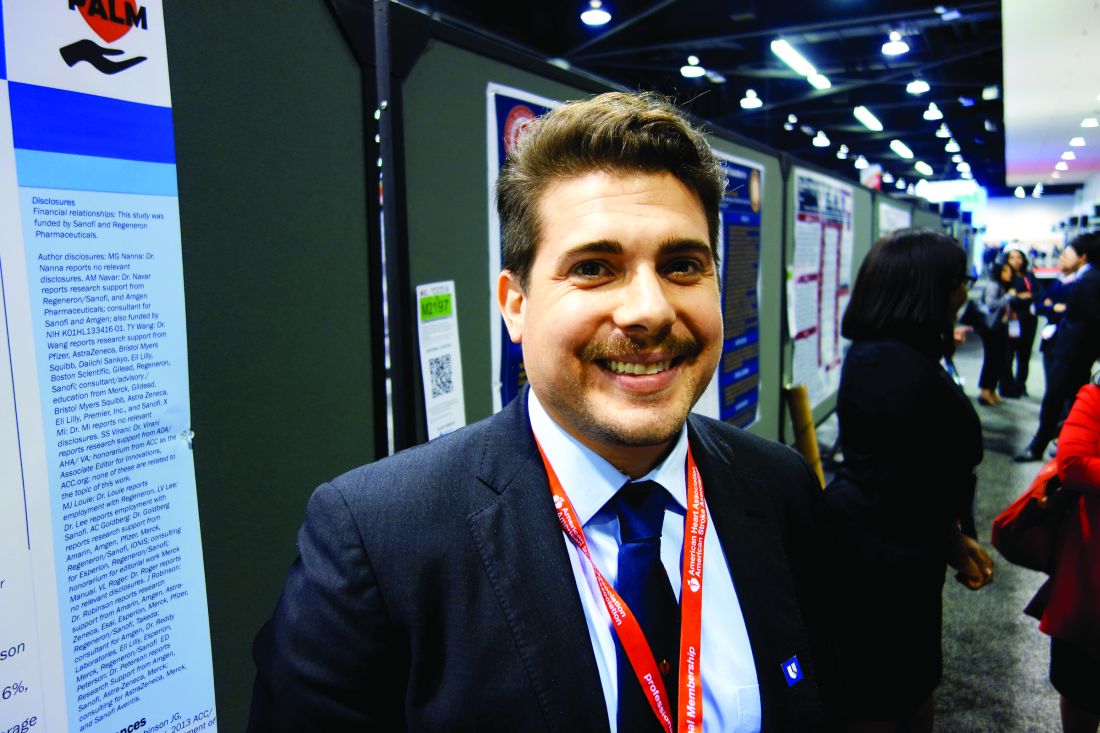User login
Young diabetics are at sevenfold increased risk of sudden cardiac death
ANAHEIM, CALIF. – Children and young adults with type 1 or type 2 diabetes have a 7.4-fold increased risk of sudden cardiac death, compared with nondiabetic, age-matched controls, according to a first-of-its-kind Danish national study.
“Luckily the absolute risk is low, but we hope these data will make [young patients with diabetes] think more about taking their insulin and following their physicians’ recommendations about treatment,” Jesper Svane said in presenting the study findings at the American Heart Association scientific sessions.
Sudden cardiac death (SCD) was the No. 1 cause of mortality in the diabetic cohort with a rate of 34.8 deaths/100,000 person-years, compared with 4.7 deaths/100,000 person-years in an age-matched nondiabetic cohort. That translates to a 7.4-fold increased risk of SCD in the diabetic cohort, noted Mr. Svane, a medical student at Copenhagen University.
When deaths caused by SCD were combined with those from other cardiac diseases, the young diabetic cohort had a rate of 68.3 deaths/100,000 person-years versus 8.2 deaths/100,000 person-years in age-matched controls, for an 8.3-fold increased risk. This observation underscores an important point: Monitoring cardiovascular risk needs to start early in young patients with diabetes.
“It’s important to pay attention when a young person with diabetes comes in complaining of chest pain or syncope,” Mr. Svane said.
The second and third most common causes of death in young Danish diabetic patients were pulmonary and endocrine diseases, which occurred at rates 7.2- and 79.2-fold greater in these patients, respectively, than in controls.
All-cause mortality occurred at a rate of 234.9 deaths/100,000 person-years in young patients with diabetes versus 50.9 deaths/100,000 person-years in matched controls, for a 4.6-fold increased risk.
Autopsies showed that the most common cause of death in diabetic persons aged 36-49 years was coronary artery disease, while in those up to age 35, it was sudden arrhythmic death syndrome, a label bestowed when a medical examiner can’t find an apparent cause of death.
Session moderator Robert H. Eckle, MD, a past AHA president, cautioned against routinely attributing the deaths without apparent cause at autopsy in young people with diabetes to sudden arrhythmic death syndrome. Given that the Danish registry data don’t include data on diabetic patients’ degree of metabolic control, it seems likely that an uncertain number of those deaths were really caused by hypoglycemia, observed Dr. Eckle, professor of medicine at the University of Colorado at Denver, Aurora.
Mr. Svane reported having no financial conflicts of interest.
SOURCE: Svane J. 2017 AHA Sessions.
ANAHEIM, CALIF. – Children and young adults with type 1 or type 2 diabetes have a 7.4-fold increased risk of sudden cardiac death, compared with nondiabetic, age-matched controls, according to a first-of-its-kind Danish national study.
“Luckily the absolute risk is low, but we hope these data will make [young patients with diabetes] think more about taking their insulin and following their physicians’ recommendations about treatment,” Jesper Svane said in presenting the study findings at the American Heart Association scientific sessions.
Sudden cardiac death (SCD) was the No. 1 cause of mortality in the diabetic cohort with a rate of 34.8 deaths/100,000 person-years, compared with 4.7 deaths/100,000 person-years in an age-matched nondiabetic cohort. That translates to a 7.4-fold increased risk of SCD in the diabetic cohort, noted Mr. Svane, a medical student at Copenhagen University.
When deaths caused by SCD were combined with those from other cardiac diseases, the young diabetic cohort had a rate of 68.3 deaths/100,000 person-years versus 8.2 deaths/100,000 person-years in age-matched controls, for an 8.3-fold increased risk. This observation underscores an important point: Monitoring cardiovascular risk needs to start early in young patients with diabetes.
“It’s important to pay attention when a young person with diabetes comes in complaining of chest pain or syncope,” Mr. Svane said.
The second and third most common causes of death in young Danish diabetic patients were pulmonary and endocrine diseases, which occurred at rates 7.2- and 79.2-fold greater in these patients, respectively, than in controls.
All-cause mortality occurred at a rate of 234.9 deaths/100,000 person-years in young patients with diabetes versus 50.9 deaths/100,000 person-years in matched controls, for a 4.6-fold increased risk.
Autopsies showed that the most common cause of death in diabetic persons aged 36-49 years was coronary artery disease, while in those up to age 35, it was sudden arrhythmic death syndrome, a label bestowed when a medical examiner can’t find an apparent cause of death.
Session moderator Robert H. Eckle, MD, a past AHA president, cautioned against routinely attributing the deaths without apparent cause at autopsy in young people with diabetes to sudden arrhythmic death syndrome. Given that the Danish registry data don’t include data on diabetic patients’ degree of metabolic control, it seems likely that an uncertain number of those deaths were really caused by hypoglycemia, observed Dr. Eckle, professor of medicine at the University of Colorado at Denver, Aurora.
Mr. Svane reported having no financial conflicts of interest.
SOURCE: Svane J. 2017 AHA Sessions.
ANAHEIM, CALIF. – Children and young adults with type 1 or type 2 diabetes have a 7.4-fold increased risk of sudden cardiac death, compared with nondiabetic, age-matched controls, according to a first-of-its-kind Danish national study.
“Luckily the absolute risk is low, but we hope these data will make [young patients with diabetes] think more about taking their insulin and following their physicians’ recommendations about treatment,” Jesper Svane said in presenting the study findings at the American Heart Association scientific sessions.
Sudden cardiac death (SCD) was the No. 1 cause of mortality in the diabetic cohort with a rate of 34.8 deaths/100,000 person-years, compared with 4.7 deaths/100,000 person-years in an age-matched nondiabetic cohort. That translates to a 7.4-fold increased risk of SCD in the diabetic cohort, noted Mr. Svane, a medical student at Copenhagen University.
When deaths caused by SCD were combined with those from other cardiac diseases, the young diabetic cohort had a rate of 68.3 deaths/100,000 person-years versus 8.2 deaths/100,000 person-years in age-matched controls, for an 8.3-fold increased risk. This observation underscores an important point: Monitoring cardiovascular risk needs to start early in young patients with diabetes.
“It’s important to pay attention when a young person with diabetes comes in complaining of chest pain or syncope,” Mr. Svane said.
The second and third most common causes of death in young Danish diabetic patients were pulmonary and endocrine diseases, which occurred at rates 7.2- and 79.2-fold greater in these patients, respectively, than in controls.
All-cause mortality occurred at a rate of 234.9 deaths/100,000 person-years in young patients with diabetes versus 50.9 deaths/100,000 person-years in matched controls, for a 4.6-fold increased risk.
Autopsies showed that the most common cause of death in diabetic persons aged 36-49 years was coronary artery disease, while in those up to age 35, it was sudden arrhythmic death syndrome, a label bestowed when a medical examiner can’t find an apparent cause of death.
Session moderator Robert H. Eckle, MD, a past AHA president, cautioned against routinely attributing the deaths without apparent cause at autopsy in young people with diabetes to sudden arrhythmic death syndrome. Given that the Danish registry data don’t include data on diabetic patients’ degree of metabolic control, it seems likely that an uncertain number of those deaths were really caused by hypoglycemia, observed Dr. Eckle, professor of medicine at the University of Colorado at Denver, Aurora.
Mr. Svane reported having no financial conflicts of interest.
SOURCE: Svane J. 2017 AHA Sessions.
REPORTING FROM THE AHA SCIENTIFIC SESSIONS
Key clinical point: Young persons with diabetes are 8.3-fold more likely to die of cardiac causes.
Major finding: In particular, the risk of sudden cardiac death in Danish children and young adults with diabetes was 7.4-fold greater than in age-matched controls.
Study details: This was a Danish national registry study of more than 14,000 children and young adults with diabetes and their rate of sudden cardiac death.
Disclosures: The study presenter reported having no financial conflicts.
Source: Svane J. 2017 AHA Sessions.
Mild cognitive impairment rises in heart patients with comorbidities
ANAHEIM, CALIF. – Across the spectrum of cardiovascular disease, the more comorbid conditions a patient has, the higher the likelihood of mild cognitive impairment, Jocasta Ball, PhD, reported at the American Heart Association scientific sessions.
Indeed, her cross-sectional analysis of baseline data on 2,161 participants in five randomized controlled trials of nurse-led chronic disease management in cardiovascular disease (CVD) showed that for every 1-unit increase in the age-adjusted Charlson Comorbidity Index, the likelihood of mild cognitive impairment (MCI) jumped by 19%.
This novel observation has important clinical implications: “MCI is becoming increasingly recognized as exerting a powerful and negative impact on the risk, management, and prognosis of CVD patients,” explained Dr. Ball of the Baker Heart and Diabetes Institute in Melbourne. “Because MCI undermines a patient’s ability to comply with medical treatment and adds to patient complexity, it is critical [to identify] higher-risk individuals who require closer surveillance and improved early intervention.”
She added that the findings open up a whole new field of research aimed at developing new interventions to help patients with CVD and MCI stay on track with their heart disease treatment program.
The 2,161 subjects, mean age 70 years and two-thirds male, ranged across the full spectrum of cardiovascular disease, from mild to severe. All were screened for MCI by completing the Montreal Cognitive Assessment, or MoCA. A MoCA score below 26 out of a possible 30 is defined as MCI.
Forty-seven percent of subjects had MCI. They were older, with a mean age of 73 years versus 67 years; were more likely to have a history of stroke, by a margin of 20% versus 12%; had a 52% prevalence of atrial fibrillation versus 44%; and had a 50% prevalence of heart failure versus 39% in subjects with normal cognition. In addition, 48% of the MCI group screened positive for depressive symptoms versus 37% of those without MCI, and 28% of patients with MCI had type 2 diabetes, compared with 22% of those without MCI. Renal disease was also significantly more prevalent in the MCI group, by a margin of 21% versus 14%.
In a multivariate regression analysis, the strongest predictors of MCI in patients across the spectrum of CVD were current smoking, with a 2.5-fold increased risk compared with that of nonsmokers, and atrial fibrillation, with a 1.3-fold increased risk.
Dr. Ball reported having no financial conflicts regarding her study.
SOURCE: Ball J. et al. AHA 2017, Abstract 16240.
ANAHEIM, CALIF. – Across the spectrum of cardiovascular disease, the more comorbid conditions a patient has, the higher the likelihood of mild cognitive impairment, Jocasta Ball, PhD, reported at the American Heart Association scientific sessions.
Indeed, her cross-sectional analysis of baseline data on 2,161 participants in five randomized controlled trials of nurse-led chronic disease management in cardiovascular disease (CVD) showed that for every 1-unit increase in the age-adjusted Charlson Comorbidity Index, the likelihood of mild cognitive impairment (MCI) jumped by 19%.
This novel observation has important clinical implications: “MCI is becoming increasingly recognized as exerting a powerful and negative impact on the risk, management, and prognosis of CVD patients,” explained Dr. Ball of the Baker Heart and Diabetes Institute in Melbourne. “Because MCI undermines a patient’s ability to comply with medical treatment and adds to patient complexity, it is critical [to identify] higher-risk individuals who require closer surveillance and improved early intervention.”
She added that the findings open up a whole new field of research aimed at developing new interventions to help patients with CVD and MCI stay on track with their heart disease treatment program.
The 2,161 subjects, mean age 70 years and two-thirds male, ranged across the full spectrum of cardiovascular disease, from mild to severe. All were screened for MCI by completing the Montreal Cognitive Assessment, or MoCA. A MoCA score below 26 out of a possible 30 is defined as MCI.
Forty-seven percent of subjects had MCI. They were older, with a mean age of 73 years versus 67 years; were more likely to have a history of stroke, by a margin of 20% versus 12%; had a 52% prevalence of atrial fibrillation versus 44%; and had a 50% prevalence of heart failure versus 39% in subjects with normal cognition. In addition, 48% of the MCI group screened positive for depressive symptoms versus 37% of those without MCI, and 28% of patients with MCI had type 2 diabetes, compared with 22% of those without MCI. Renal disease was also significantly more prevalent in the MCI group, by a margin of 21% versus 14%.
In a multivariate regression analysis, the strongest predictors of MCI in patients across the spectrum of CVD were current smoking, with a 2.5-fold increased risk compared with that of nonsmokers, and atrial fibrillation, with a 1.3-fold increased risk.
Dr. Ball reported having no financial conflicts regarding her study.
SOURCE: Ball J. et al. AHA 2017, Abstract 16240.
ANAHEIM, CALIF. – Across the spectrum of cardiovascular disease, the more comorbid conditions a patient has, the higher the likelihood of mild cognitive impairment, Jocasta Ball, PhD, reported at the American Heart Association scientific sessions.
Indeed, her cross-sectional analysis of baseline data on 2,161 participants in five randomized controlled trials of nurse-led chronic disease management in cardiovascular disease (CVD) showed that for every 1-unit increase in the age-adjusted Charlson Comorbidity Index, the likelihood of mild cognitive impairment (MCI) jumped by 19%.
This novel observation has important clinical implications: “MCI is becoming increasingly recognized as exerting a powerful and negative impact on the risk, management, and prognosis of CVD patients,” explained Dr. Ball of the Baker Heart and Diabetes Institute in Melbourne. “Because MCI undermines a patient’s ability to comply with medical treatment and adds to patient complexity, it is critical [to identify] higher-risk individuals who require closer surveillance and improved early intervention.”
She added that the findings open up a whole new field of research aimed at developing new interventions to help patients with CVD and MCI stay on track with their heart disease treatment program.
The 2,161 subjects, mean age 70 years and two-thirds male, ranged across the full spectrum of cardiovascular disease, from mild to severe. All were screened for MCI by completing the Montreal Cognitive Assessment, or MoCA. A MoCA score below 26 out of a possible 30 is defined as MCI.
Forty-seven percent of subjects had MCI. They were older, with a mean age of 73 years versus 67 years; were more likely to have a history of stroke, by a margin of 20% versus 12%; had a 52% prevalence of atrial fibrillation versus 44%; and had a 50% prevalence of heart failure versus 39% in subjects with normal cognition. In addition, 48% of the MCI group screened positive for depressive symptoms versus 37% of those without MCI, and 28% of patients with MCI had type 2 diabetes, compared with 22% of those without MCI. Renal disease was also significantly more prevalent in the MCI group, by a margin of 21% versus 14%.
In a multivariate regression analysis, the strongest predictors of MCI in patients across the spectrum of CVD were current smoking, with a 2.5-fold increased risk compared with that of nonsmokers, and atrial fibrillation, with a 1.3-fold increased risk.
Dr. Ball reported having no financial conflicts regarding her study.
SOURCE: Ball J. et al. AHA 2017, Abstract 16240.
REPORTING FROM THE AHA SCIENTIFIC SESSIONS
Key clinical point: The more comorbid conditions a patient with cardiovascular disease has, the greater the likelihood of mild cognitive impairment becomes.
Major finding: For each 1-unit increase in the Charlson Comorbidity Index, the likelihood of prevalent mild cognitive impairment rose by 19%.
Study details: This cross-sectional study assessed the association between mild cognitive impairment and Charlson Comorbidity Index score in 2,161 patients with cardiovascular disease of varied degrees of severity.
Disclosures: The presenter reported having no financial conflicts regarding her study.
Source: Ball J et al. AHA 2017, Abstract 16240
Aspirin may protect against dementia in T2DM
ANAHEIM, CALIF. – in the randomized JPAD 2 study, Chisa Matsumoto, MD, reported at the American Heart Association scientific sessions.
The benefit was restricted to women with T2DM. During a median 9.7 years of follow-up, the incidence of dementia, as defined by prescription of antidementia drugs or hospitalization for dementia, was 2.7 cases per 1,000 person-years in women randomized to low-dose aspirin and 6 per 1,000 person-years in those assigned to standard care. This translated to a 60% relative risk reduction in a multivariate analysis adjusted for age, hypertension, dyslipidemia, smoking, and hemoglobin A1c level, according to Dr. Matsumoto of Hyogo (Japan) College of Medicine.
JPAD 2 was a multicenter prospective cohort study of 2,536 Japanese patients with T2DM who previously participated in the open-label randomized Japanese Primary Prevention of Atherosclerosis with Aspirin for Diabetes (JPAD) trial, which ran from 2002 to 2008. Patients’ average age at baseline was 64 years; they had a 7-year duration of diabetes and no history of cardiovascular disease or dementia. When JPAD ended, patients continued on in JPAD 2, with follow-up through July 2015.
In the overall JPAD 2 population, the dementia incidence rate was 3.6 per 1,000 person-years in the low-dose aspirin group compared with 4.9 per 1,000 person-years in controls, for a highly significant 35% relative risk reduction in a fully adjusted multivariate intention to treat analysis.
During follow-up, 15% of patients switched from low-dose aspirin to no aspirin or vice versa, prompting Dr. Matsumoto and her coinvestigators to perform a per protocol analysis of the data. The results were essentially the same as in the intent-to-treat analysis.
JPAD 2 was the first-ever study to evaluate the long-term efficacy of low-dose aspirin for prevention of dementia specifically in patients with T2DM, a known risk factor for dementia. Other observational and randomized controlled studies have yielded inconsistent results. For example, a recent meta-analysis of five studies with a median 6-year follow-up found an 18% relative risk reduction in onset of dementia or cognitive impairment, a difference that didn’t achieve statistical significance (J Am Geriatr Soc. 2017 Aug;65[8]:1763-8).
Some prior studies have suggested there is a sex-based difference in the risk of dementia, which prompted Dr. Matsumoto and her coinvestigators to analyze the JPAD 2 results separately in men and women.
She was quick to acknowledge that the novel JPAD 2 findings cry out for replication in other studies with larger numbers and/or longer follow-up.
Session moderator Mary Cushman, MD, declared, “I think this is really exciting and interesting.”
Asked to speculate on the mechanism for the divergent efficacy of low-dose aspirin in men and women with T2DM in JPAD 2, Dr. Matsumoto said play of chance may have had a partial role. The incidence of dementia was roughly 50% greater in the JPAD 2 women than in the men, so the study may have been underpowered to look at the dementia rate in men. But there may be a biologic mechanism at work, as well: Apolipoprotein E4, which is linked to increased risk of dementia, is believed to interact with gender, she said.
Dr. Matsumoto reported having no financial conflicts.
SOURCE: Matsumoto C. AHA scientific sessions.
ANAHEIM, CALIF. – in the randomized JPAD 2 study, Chisa Matsumoto, MD, reported at the American Heart Association scientific sessions.
The benefit was restricted to women with T2DM. During a median 9.7 years of follow-up, the incidence of dementia, as defined by prescription of antidementia drugs or hospitalization for dementia, was 2.7 cases per 1,000 person-years in women randomized to low-dose aspirin and 6 per 1,000 person-years in those assigned to standard care. This translated to a 60% relative risk reduction in a multivariate analysis adjusted for age, hypertension, dyslipidemia, smoking, and hemoglobin A1c level, according to Dr. Matsumoto of Hyogo (Japan) College of Medicine.
JPAD 2 was a multicenter prospective cohort study of 2,536 Japanese patients with T2DM who previously participated in the open-label randomized Japanese Primary Prevention of Atherosclerosis with Aspirin for Diabetes (JPAD) trial, which ran from 2002 to 2008. Patients’ average age at baseline was 64 years; they had a 7-year duration of diabetes and no history of cardiovascular disease or dementia. When JPAD ended, patients continued on in JPAD 2, with follow-up through July 2015.
In the overall JPAD 2 population, the dementia incidence rate was 3.6 per 1,000 person-years in the low-dose aspirin group compared with 4.9 per 1,000 person-years in controls, for a highly significant 35% relative risk reduction in a fully adjusted multivariate intention to treat analysis.
During follow-up, 15% of patients switched from low-dose aspirin to no aspirin or vice versa, prompting Dr. Matsumoto and her coinvestigators to perform a per protocol analysis of the data. The results were essentially the same as in the intent-to-treat analysis.
JPAD 2 was the first-ever study to evaluate the long-term efficacy of low-dose aspirin for prevention of dementia specifically in patients with T2DM, a known risk factor for dementia. Other observational and randomized controlled studies have yielded inconsistent results. For example, a recent meta-analysis of five studies with a median 6-year follow-up found an 18% relative risk reduction in onset of dementia or cognitive impairment, a difference that didn’t achieve statistical significance (J Am Geriatr Soc. 2017 Aug;65[8]:1763-8).
Some prior studies have suggested there is a sex-based difference in the risk of dementia, which prompted Dr. Matsumoto and her coinvestigators to analyze the JPAD 2 results separately in men and women.
She was quick to acknowledge that the novel JPAD 2 findings cry out for replication in other studies with larger numbers and/or longer follow-up.
Session moderator Mary Cushman, MD, declared, “I think this is really exciting and interesting.”
Asked to speculate on the mechanism for the divergent efficacy of low-dose aspirin in men and women with T2DM in JPAD 2, Dr. Matsumoto said play of chance may have had a partial role. The incidence of dementia was roughly 50% greater in the JPAD 2 women than in the men, so the study may have been underpowered to look at the dementia rate in men. But there may be a biologic mechanism at work, as well: Apolipoprotein E4, which is linked to increased risk of dementia, is believed to interact with gender, she said.
Dr. Matsumoto reported having no financial conflicts.
SOURCE: Matsumoto C. AHA scientific sessions.
ANAHEIM, CALIF. – in the randomized JPAD 2 study, Chisa Matsumoto, MD, reported at the American Heart Association scientific sessions.
The benefit was restricted to women with T2DM. During a median 9.7 years of follow-up, the incidence of dementia, as defined by prescription of antidementia drugs or hospitalization for dementia, was 2.7 cases per 1,000 person-years in women randomized to low-dose aspirin and 6 per 1,000 person-years in those assigned to standard care. This translated to a 60% relative risk reduction in a multivariate analysis adjusted for age, hypertension, dyslipidemia, smoking, and hemoglobin A1c level, according to Dr. Matsumoto of Hyogo (Japan) College of Medicine.
JPAD 2 was a multicenter prospective cohort study of 2,536 Japanese patients with T2DM who previously participated in the open-label randomized Japanese Primary Prevention of Atherosclerosis with Aspirin for Diabetes (JPAD) trial, which ran from 2002 to 2008. Patients’ average age at baseline was 64 years; they had a 7-year duration of diabetes and no history of cardiovascular disease or dementia. When JPAD ended, patients continued on in JPAD 2, with follow-up through July 2015.
In the overall JPAD 2 population, the dementia incidence rate was 3.6 per 1,000 person-years in the low-dose aspirin group compared with 4.9 per 1,000 person-years in controls, for a highly significant 35% relative risk reduction in a fully adjusted multivariate intention to treat analysis.
During follow-up, 15% of patients switched from low-dose aspirin to no aspirin or vice versa, prompting Dr. Matsumoto and her coinvestigators to perform a per protocol analysis of the data. The results were essentially the same as in the intent-to-treat analysis.
JPAD 2 was the first-ever study to evaluate the long-term efficacy of low-dose aspirin for prevention of dementia specifically in patients with T2DM, a known risk factor for dementia. Other observational and randomized controlled studies have yielded inconsistent results. For example, a recent meta-analysis of five studies with a median 6-year follow-up found an 18% relative risk reduction in onset of dementia or cognitive impairment, a difference that didn’t achieve statistical significance (J Am Geriatr Soc. 2017 Aug;65[8]:1763-8).
Some prior studies have suggested there is a sex-based difference in the risk of dementia, which prompted Dr. Matsumoto and her coinvestigators to analyze the JPAD 2 results separately in men and women.
She was quick to acknowledge that the novel JPAD 2 findings cry out for replication in other studies with larger numbers and/or longer follow-up.
Session moderator Mary Cushman, MD, declared, “I think this is really exciting and interesting.”
Asked to speculate on the mechanism for the divergent efficacy of low-dose aspirin in men and women with T2DM in JPAD 2, Dr. Matsumoto said play of chance may have had a partial role. The incidence of dementia was roughly 50% greater in the JPAD 2 women than in the men, so the study may have been underpowered to look at the dementia rate in men. But there may be a biologic mechanism at work, as well: Apolipoprotein E4, which is linked to increased risk of dementia, is believed to interact with gender, she said.
Dr. Matsumoto reported having no financial conflicts.
SOURCE: Matsumoto C. AHA scientific sessions.
REPORTING FROM THE AHA SCIENTIFIC SESSIONS
Key clinical point:
Major finding: Daily low-dose aspirin reduced the incidence of dementia by more than one-third in patients with type 2 diabetes.
Study details: A multicenter randomized prospective cohort study of 2,536 patients with type 2 diabetes.
Disclosures: The study presenter reported having no financial conflicts.
Source: Matsumoto C. AHA scientific sessions.
Adding hypertension in pregnancy doesn’t refine ASCVD risk prediction tool
ANAHEIM, CALIF. – The first-ever study to examine the clinical utility of incorporating a history of hypertensive disorders of pregnancy into the American College of Cardiology/American Heart Association Atherosclerotic Cardiovascular Disease Risk Calculator in an effort to better delineate risk in women failed to show any added benefit.
But that doesn’t mean such a history is without value in daily clinical practice, Jennifer J. Stuart, ScD, asserted at the American Heart Association scientific sessions.
“While we did not demonstrate that hypertensive disorders of pregnancy improved cardiovascular risk discrimination in women, we do still believe – and I still believe – that hypertensive disorders of pregnancy remain an important risk marker for cardiovascular disease in women,” said Dr. Stuart of the Harvard School of Public Health, Boston.
“In this latest analysis we’ve demonstrated over a fourfold increased risk of chronic hypertension in these women in the first 5 years after delivery. So we do see increased risk very soon after delivery, and it persists for decades. And hypertensive disorders of pregnancy as a risk marker does offer practical advantages: ease of ascertainment, low cost, and availability earlier in life,” the researcher noted.
Her study hypothesis was that adding hypertensive disorders of pregnancy – that is, gestational hypertension and preeclampsia – and parity to the current ACC/AHA ASCVD Risk Calculator would enhance the tool’s predictive tool’s power in women.
“We wanted to know if a history of hypertensive disorders of pregnancy can be leveraged to capture women currently being missed in screening,” she explained.
Her expectation that this would be the case was based on solid evidence that hypertensive disorders of pregnancy, which occur in 10%-15% of all pregnancies, are associated with subsequent increased risk of cardiovascular events. For example, a meta-analysis of published studies involving nearly 3.5 million women, including almost 200,000 with a history of preeclampsia, showed that preeclampsia was associated with a 2.16-fold increased risk of ischemic heart disease during 11.7 years of follow-up (BMJ. 2007 Nov 10;335[7627]:974). This meta-analysis was among the evidence that persuaded the AHA in 2011 to formally add hypertensive disorders of pregnancy to the list of risk factors for cardiovascular disease in women (Circulation. 2011 Mar 22;123[11]:1243-62).
Dr. Stuart also incorporated parity in her investigational revised ASCVD risk model, because parity has been shown to be an independent risk factor of cardiovascular disease in a relationship described by a J-shaped curve.
She put the souped-up risk prediction model to the test by separately applying it and the current version to data from the longitudinal prospective Nurses’ Health Study II. For this analysis, nearly 68,000 female registered nurses were followed for new diseases every 2 years from 1989, when they were aged 25-42, through 2013. She and her coinvestigators applied the two 10-year risk-prediction models to the overall cohort and again separately to women at aged 40-49 and 50-59.
The bottom line: This might be because the nurses comprise a relatively low-risk population. Also, even though hypertensive disorders of pregnancy are associated with 10-year cardiovascular disease risk independent of the established risk factors, there may be enough overlap that the standard risk factors sufficiently capture the risk.
“It may be that the information on history of hypertensive disorders of pregnancy should be ascertained in the 20s and 30s, rather than waiting until age 40 or later, when we generally apply cardiovascular risk scores in practice. That [earlier assessment] may be a really important and valuable opportunity to identify these women at high risk and utilize primary prevention,” according to Dr. Stuart.
What’s next? “I’m certainly interested in educating these women about their increased risk. This is not something that’s done consistently across the country and across practices, and we really believe this is an important message for women to get when they deliver these pregnancies,” she added.
Dr. Stuart reported having no financial conflicts of interest regarding her study.
SOURCE: Stuart JJ. AHA Scientific Sessions.
ANAHEIM, CALIF. – The first-ever study to examine the clinical utility of incorporating a history of hypertensive disorders of pregnancy into the American College of Cardiology/American Heart Association Atherosclerotic Cardiovascular Disease Risk Calculator in an effort to better delineate risk in women failed to show any added benefit.
But that doesn’t mean such a history is without value in daily clinical practice, Jennifer J. Stuart, ScD, asserted at the American Heart Association scientific sessions.
“While we did not demonstrate that hypertensive disorders of pregnancy improved cardiovascular risk discrimination in women, we do still believe – and I still believe – that hypertensive disorders of pregnancy remain an important risk marker for cardiovascular disease in women,” said Dr. Stuart of the Harvard School of Public Health, Boston.
“In this latest analysis we’ve demonstrated over a fourfold increased risk of chronic hypertension in these women in the first 5 years after delivery. So we do see increased risk very soon after delivery, and it persists for decades. And hypertensive disorders of pregnancy as a risk marker does offer practical advantages: ease of ascertainment, low cost, and availability earlier in life,” the researcher noted.
Her study hypothesis was that adding hypertensive disorders of pregnancy – that is, gestational hypertension and preeclampsia – and parity to the current ACC/AHA ASCVD Risk Calculator would enhance the tool’s predictive tool’s power in women.
“We wanted to know if a history of hypertensive disorders of pregnancy can be leveraged to capture women currently being missed in screening,” she explained.
Her expectation that this would be the case was based on solid evidence that hypertensive disorders of pregnancy, which occur in 10%-15% of all pregnancies, are associated with subsequent increased risk of cardiovascular events. For example, a meta-analysis of published studies involving nearly 3.5 million women, including almost 200,000 with a history of preeclampsia, showed that preeclampsia was associated with a 2.16-fold increased risk of ischemic heart disease during 11.7 years of follow-up (BMJ. 2007 Nov 10;335[7627]:974). This meta-analysis was among the evidence that persuaded the AHA in 2011 to formally add hypertensive disorders of pregnancy to the list of risk factors for cardiovascular disease in women (Circulation. 2011 Mar 22;123[11]:1243-62).
Dr. Stuart also incorporated parity in her investigational revised ASCVD risk model, because parity has been shown to be an independent risk factor of cardiovascular disease in a relationship described by a J-shaped curve.
She put the souped-up risk prediction model to the test by separately applying it and the current version to data from the longitudinal prospective Nurses’ Health Study II. For this analysis, nearly 68,000 female registered nurses were followed for new diseases every 2 years from 1989, when they were aged 25-42, through 2013. She and her coinvestigators applied the two 10-year risk-prediction models to the overall cohort and again separately to women at aged 40-49 and 50-59.
The bottom line: This might be because the nurses comprise a relatively low-risk population. Also, even though hypertensive disorders of pregnancy are associated with 10-year cardiovascular disease risk independent of the established risk factors, there may be enough overlap that the standard risk factors sufficiently capture the risk.
“It may be that the information on history of hypertensive disorders of pregnancy should be ascertained in the 20s and 30s, rather than waiting until age 40 or later, when we generally apply cardiovascular risk scores in practice. That [earlier assessment] may be a really important and valuable opportunity to identify these women at high risk and utilize primary prevention,” according to Dr. Stuart.
What’s next? “I’m certainly interested in educating these women about their increased risk. This is not something that’s done consistently across the country and across practices, and we really believe this is an important message for women to get when they deliver these pregnancies,” she added.
Dr. Stuart reported having no financial conflicts of interest regarding her study.
SOURCE: Stuart JJ. AHA Scientific Sessions.
ANAHEIM, CALIF. – The first-ever study to examine the clinical utility of incorporating a history of hypertensive disorders of pregnancy into the American College of Cardiology/American Heart Association Atherosclerotic Cardiovascular Disease Risk Calculator in an effort to better delineate risk in women failed to show any added benefit.
But that doesn’t mean such a history is without value in daily clinical practice, Jennifer J. Stuart, ScD, asserted at the American Heart Association scientific sessions.
“While we did not demonstrate that hypertensive disorders of pregnancy improved cardiovascular risk discrimination in women, we do still believe – and I still believe – that hypertensive disorders of pregnancy remain an important risk marker for cardiovascular disease in women,” said Dr. Stuart of the Harvard School of Public Health, Boston.
“In this latest analysis we’ve demonstrated over a fourfold increased risk of chronic hypertension in these women in the first 5 years after delivery. So we do see increased risk very soon after delivery, and it persists for decades. And hypertensive disorders of pregnancy as a risk marker does offer practical advantages: ease of ascertainment, low cost, and availability earlier in life,” the researcher noted.
Her study hypothesis was that adding hypertensive disorders of pregnancy – that is, gestational hypertension and preeclampsia – and parity to the current ACC/AHA ASCVD Risk Calculator would enhance the tool’s predictive tool’s power in women.
“We wanted to know if a history of hypertensive disorders of pregnancy can be leveraged to capture women currently being missed in screening,” she explained.
Her expectation that this would be the case was based on solid evidence that hypertensive disorders of pregnancy, which occur in 10%-15% of all pregnancies, are associated with subsequent increased risk of cardiovascular events. For example, a meta-analysis of published studies involving nearly 3.5 million women, including almost 200,000 with a history of preeclampsia, showed that preeclampsia was associated with a 2.16-fold increased risk of ischemic heart disease during 11.7 years of follow-up (BMJ. 2007 Nov 10;335[7627]:974). This meta-analysis was among the evidence that persuaded the AHA in 2011 to formally add hypertensive disorders of pregnancy to the list of risk factors for cardiovascular disease in women (Circulation. 2011 Mar 22;123[11]:1243-62).
Dr. Stuart also incorporated parity in her investigational revised ASCVD risk model, because parity has been shown to be an independent risk factor of cardiovascular disease in a relationship described by a J-shaped curve.
She put the souped-up risk prediction model to the test by separately applying it and the current version to data from the longitudinal prospective Nurses’ Health Study II. For this analysis, nearly 68,000 female registered nurses were followed for new diseases every 2 years from 1989, when they were aged 25-42, through 2013. She and her coinvestigators applied the two 10-year risk-prediction models to the overall cohort and again separately to women at aged 40-49 and 50-59.
The bottom line: This might be because the nurses comprise a relatively low-risk population. Also, even though hypertensive disorders of pregnancy are associated with 10-year cardiovascular disease risk independent of the established risk factors, there may be enough overlap that the standard risk factors sufficiently capture the risk.
“It may be that the information on history of hypertensive disorders of pregnancy should be ascertained in the 20s and 30s, rather than waiting until age 40 or later, when we generally apply cardiovascular risk scores in practice. That [earlier assessment] may be a really important and valuable opportunity to identify these women at high risk and utilize primary prevention,” according to Dr. Stuart.
What’s next? “I’m certainly interested in educating these women about their increased risk. This is not something that’s done consistently across the country and across practices, and we really believe this is an important message for women to get when they deliver these pregnancies,” she added.
Dr. Stuart reported having no financial conflicts of interest regarding her study.
SOURCE: Stuart JJ. AHA Scientific Sessions.
REPORTING FROM THE AHA SCIENTIFIC SESSIONS
Key clinical point: The ACC/AHA Atherosclerotic Cardiovascular Disease Risk Calculator doesn’t do a better job of predicting 10-year risk in women when a history of hypertensive disorders of pregnancy is added into the formula.
Major finding: Incorporating a woman’s history of hypertensive disorders of pregnancy into the Atherosclerotic Cardiovascular Disease Risk Calculator doesn’t improve the tool’s accuracy in predicting 10-year risk.
Study details: An analysis of data from the longitudinal, prospective Nurses’ Health Study II.
Disclosures: The study presenter reported having no financial conflicts of interest.
Source: Stuart JJ. AHA Scientific Sessions.
Embracing Life’s Simple 7 slashes PAD risk
ANAHEIM, CALIF. – Adherence to the American Heart Association’s widely publicized “Life’s Simple 7” program addressing key modifiable cardiovascular health factors substantially reduces the risk of developing peripheral arterial disease, Parveen Garg, MD, said at the American Heart Association scientific sessions.
This is new evidence-supported information. Until this new analysis from the landmark ARIC (Atherosclerosis Risk in Communities) study, the relationship between Life’s Simple 7 and peripheral arterial disease (PAD) hadn’t been studied. It’s a relationship worthy of examination, considering that more than 8 million Americans have PAD, and nearly 40% of them don’t have concomitant coronary or cerebrovascular disease, which raised the question of whether Life’s Simple 7 applied to PAD risk, noted Dr. Garg of the University of Southern California, Los Angeles.
ARIC is a National Heart, Lung, and Blood Institute–sponsored prospective study of nearly 16,000 black or white individuals who were middle-aged at enrollment and have been followed for more than 2 decades. Dr. Garg’s analysis focused on 12,865 participants who were free of CHD, heart failure, prior stroke, and PAD at baseline, and have been followed for a median of 24 years.
As background, the metrics for Life’s Simple 7 consist of total cholesterol, blood pressure, blood glucose, smoking status, body mass index, physical activity, and adherence to a healthy diet score. Each element can be scored 2 points for ideal, 1 for intermediate, and 0 for poor. The composite Life’s Simple 7 score is rated optimal at 10-14 points, average at 5-9, and inadequate at 0-4.
During follow-up, 3.4% of ARIC participants developed PAD sufficiently severe to involve hospitalization. The incidence rate was 5.2 cases per 1,000 person-years for the 1,008 subjects categorized as having an inadequate Life’s Simple 7 score, 1.1/1,000 person-years for the 8,395 people in the average category, and just 0.4 cases/1,000 person-years for the 3,462 individuals in the optimal Life’s Simple 7 group.
Compared with subjects in the inadequate category, those in the average group were 56% less likely to develop PAD. Those in the optimal Life’s Simple 7 category had an 86% reduction in risk.
For each of the seven components of Life’s Simple 7 a person scored ideally in, the risk of incident PAD was reduced by 28% in a multivariate analysis fully adjusted for demographics, alcohol consumption, aspirin use, study site, left ventricular hypertrophy, and other potential confounders.
The inverse relationship between Life’s Simple 7 score and PAD risk was stronger in women than men. However, the association didn’t differ by race.
Dr. Garg noted that his study undoubtedly underestimates the true incidence of PAD in the ARIC population, since a hospital diagnosis was required. Also, to date he and his coinvestigators have only analyzed the results in terms of baseline Life’s Simple 7 score. It would be useful to also document the impact of change in the score over time.
Session moderator David C. Goff Jr., MD, observed, “This is very consistent with evidence in CHD that people who are in ideal cardiovascular health status have about an 80%-90% lower risk of cardiovascular mortality and a 70%-80% reduction in risk of total mortality compared with people who are in poor cardiovascular health status.”
“This study really does provide additional evidence that if we could get more people into the ideal cardiovascular health range, we’d probably see less atherosclerotic cardiovascular disease in general,” added Dr. Goff, who is director of the division of cardiovascular sciences at the National Heart, Lung, and Blood Institute.
Dr. Garg reported having no financial conflicts of interest.
ANAHEIM, CALIF. – Adherence to the American Heart Association’s widely publicized “Life’s Simple 7” program addressing key modifiable cardiovascular health factors substantially reduces the risk of developing peripheral arterial disease, Parveen Garg, MD, said at the American Heart Association scientific sessions.
This is new evidence-supported information. Until this new analysis from the landmark ARIC (Atherosclerosis Risk in Communities) study, the relationship between Life’s Simple 7 and peripheral arterial disease (PAD) hadn’t been studied. It’s a relationship worthy of examination, considering that more than 8 million Americans have PAD, and nearly 40% of them don’t have concomitant coronary or cerebrovascular disease, which raised the question of whether Life’s Simple 7 applied to PAD risk, noted Dr. Garg of the University of Southern California, Los Angeles.
ARIC is a National Heart, Lung, and Blood Institute–sponsored prospective study of nearly 16,000 black or white individuals who were middle-aged at enrollment and have been followed for more than 2 decades. Dr. Garg’s analysis focused on 12,865 participants who were free of CHD, heart failure, prior stroke, and PAD at baseline, and have been followed for a median of 24 years.
As background, the metrics for Life’s Simple 7 consist of total cholesterol, blood pressure, blood glucose, smoking status, body mass index, physical activity, and adherence to a healthy diet score. Each element can be scored 2 points for ideal, 1 for intermediate, and 0 for poor. The composite Life’s Simple 7 score is rated optimal at 10-14 points, average at 5-9, and inadequate at 0-4.
During follow-up, 3.4% of ARIC participants developed PAD sufficiently severe to involve hospitalization. The incidence rate was 5.2 cases per 1,000 person-years for the 1,008 subjects categorized as having an inadequate Life’s Simple 7 score, 1.1/1,000 person-years for the 8,395 people in the average category, and just 0.4 cases/1,000 person-years for the 3,462 individuals in the optimal Life’s Simple 7 group.
Compared with subjects in the inadequate category, those in the average group were 56% less likely to develop PAD. Those in the optimal Life’s Simple 7 category had an 86% reduction in risk.
For each of the seven components of Life’s Simple 7 a person scored ideally in, the risk of incident PAD was reduced by 28% in a multivariate analysis fully adjusted for demographics, alcohol consumption, aspirin use, study site, left ventricular hypertrophy, and other potential confounders.
The inverse relationship between Life’s Simple 7 score and PAD risk was stronger in women than men. However, the association didn’t differ by race.
Dr. Garg noted that his study undoubtedly underestimates the true incidence of PAD in the ARIC population, since a hospital diagnosis was required. Also, to date he and his coinvestigators have only analyzed the results in terms of baseline Life’s Simple 7 score. It would be useful to also document the impact of change in the score over time.
Session moderator David C. Goff Jr., MD, observed, “This is very consistent with evidence in CHD that people who are in ideal cardiovascular health status have about an 80%-90% lower risk of cardiovascular mortality and a 70%-80% reduction in risk of total mortality compared with people who are in poor cardiovascular health status.”
“This study really does provide additional evidence that if we could get more people into the ideal cardiovascular health range, we’d probably see less atherosclerotic cardiovascular disease in general,” added Dr. Goff, who is director of the division of cardiovascular sciences at the National Heart, Lung, and Blood Institute.
Dr. Garg reported having no financial conflicts of interest.
ANAHEIM, CALIF. – Adherence to the American Heart Association’s widely publicized “Life’s Simple 7” program addressing key modifiable cardiovascular health factors substantially reduces the risk of developing peripheral arterial disease, Parveen Garg, MD, said at the American Heart Association scientific sessions.
This is new evidence-supported information. Until this new analysis from the landmark ARIC (Atherosclerosis Risk in Communities) study, the relationship between Life’s Simple 7 and peripheral arterial disease (PAD) hadn’t been studied. It’s a relationship worthy of examination, considering that more than 8 million Americans have PAD, and nearly 40% of them don’t have concomitant coronary or cerebrovascular disease, which raised the question of whether Life’s Simple 7 applied to PAD risk, noted Dr. Garg of the University of Southern California, Los Angeles.
ARIC is a National Heart, Lung, and Blood Institute–sponsored prospective study of nearly 16,000 black or white individuals who were middle-aged at enrollment and have been followed for more than 2 decades. Dr. Garg’s analysis focused on 12,865 participants who were free of CHD, heart failure, prior stroke, and PAD at baseline, and have been followed for a median of 24 years.
As background, the metrics for Life’s Simple 7 consist of total cholesterol, blood pressure, blood glucose, smoking status, body mass index, physical activity, and adherence to a healthy diet score. Each element can be scored 2 points for ideal, 1 for intermediate, and 0 for poor. The composite Life’s Simple 7 score is rated optimal at 10-14 points, average at 5-9, and inadequate at 0-4.
During follow-up, 3.4% of ARIC participants developed PAD sufficiently severe to involve hospitalization. The incidence rate was 5.2 cases per 1,000 person-years for the 1,008 subjects categorized as having an inadequate Life’s Simple 7 score, 1.1/1,000 person-years for the 8,395 people in the average category, and just 0.4 cases/1,000 person-years for the 3,462 individuals in the optimal Life’s Simple 7 group.
Compared with subjects in the inadequate category, those in the average group were 56% less likely to develop PAD. Those in the optimal Life’s Simple 7 category had an 86% reduction in risk.
For each of the seven components of Life’s Simple 7 a person scored ideally in, the risk of incident PAD was reduced by 28% in a multivariate analysis fully adjusted for demographics, alcohol consumption, aspirin use, study site, left ventricular hypertrophy, and other potential confounders.
The inverse relationship between Life’s Simple 7 score and PAD risk was stronger in women than men. However, the association didn’t differ by race.
Dr. Garg noted that his study undoubtedly underestimates the true incidence of PAD in the ARIC population, since a hospital diagnosis was required. Also, to date he and his coinvestigators have only analyzed the results in terms of baseline Life’s Simple 7 score. It would be useful to also document the impact of change in the score over time.
Session moderator David C. Goff Jr., MD, observed, “This is very consistent with evidence in CHD that people who are in ideal cardiovascular health status have about an 80%-90% lower risk of cardiovascular mortality and a 70%-80% reduction in risk of total mortality compared with people who are in poor cardiovascular health status.”
“This study really does provide additional evidence that if we could get more people into the ideal cardiovascular health range, we’d probably see less atherosclerotic cardiovascular disease in general,” added Dr. Goff, who is director of the division of cardiovascular sciences at the National Heart, Lung, and Blood Institute.
Dr. Garg reported having no financial conflicts of interest.
REPORTING FROM THE AHA SCIENTIFIC SESSIONS
Key clinical point: The Life’s Simple 7 public health program points the way to reduced risk of PAD.
Major finding: Being in the top tertile of cardiovascular health by the American Heart Association’s Life’s Simple 7 metric is associated with an 86% lower risk of developing PAD than for those in poor cardiovascular health.
Study details: This biracial prospective observational study includes nearly 16,000 white and black Americans.
Disclosures: The ARIC study is funded by the NHLBI. The presenter reported having no financial conflicts.
Canagliflozin falls short for primary CV prevention in T2DM
ANAHEIM, CALIF. – The first large randomized trial to report results on a sodium glucose cotransporter 2 inhibitor for primary prevention of cardiovascular events in patients with type 2 diabetes who are at risk for cardiovascular events or death failed to show a significant benefit in the CANVAS program, Kenneth W. Mahaffey, MD, said at the American Heart Association scientific sessions.
The impressive reductions in cardiovascular and renal events seen in the overall CANVAS (Canagliflozin Cardiovascular Assessment Study) program turned out to be focused in the two-thirds of participants with a prior cardiovascular event at enrollment, according to Dr. Mahaffey, a cardiologist who is professor and vice chair of the department of medicine at Stanford (Calif.) University.
The primary outcome has previously been reported: The canagliflozin group had a highly significant 14% reduction in the risk of the composite endpoint of cardiovascular death, nonfatal MI, or nonfatal stroke (N Engl J Med. 2017 Aug 17;377[7]:644-57).
At the AHA scientific sessions, Dr. Mahaffey presented a prespecified subgroup analysis comparing the impact of SGLT2 inhibitor for primary versus secondary cardiovascular prevention. Canagliflozin proved to be a big win for secondary prevention: The composite primary endpoint was reduced by 18%, compared with placebo; the composite renal outcome of worsening estimated glomerular filtration rate (eGFR), renal replacement, or renal death was reduced by 41%; and heart failure hospitalizations were reduced by 32%.
All of those benefits were strongly statistically significant. They came at the cost of roughly a fourfold increase in readily treatable male and female genital infections – a known class effect of the SGLT2 inhibitors – as well as an unexpected twofold increase in lower extremity amputations, which fortunately were uncommon. Of the amputations, 29% were above the ankle; the other 71% were less drastic toe or transmetatarsal procedures.
Dr. Mahaffey estimated that for every 1,000 patients with type 2 diabetes who were taking canagliflozin for secondary cardiovascular prevention for 5 years, there would be 36 fewer cardiovascular deaths, nonfatal MIs, or nonfatal strokes; 20 fewer hospitalizations for heart failure; 21 fewer patients who experienced the composite renal outcome; and 21 additional patients with a lower extremity amputation.
Rates of cardiovascular and renal endpoints were at least twofold higher in the secondary prevention group than in the primary prevention cohort. For prevention, the size of the relative risk reductions in heart failure hospitalizations and renal outcomes with canagliflozin, compared with placebo, were similar to the secondary prevention experience. So was the magnitude of the increased risk of lower extremity amputation. However, none of these differences achieved statistical significance, perhaps because of the lower absolute event rates in the primary prevention group.
Moreover, there was no signal of benefit for canagliflozin in terms of the composite outcome of cardiovascular death, nonfatal MI, or nonfatal stroke in the primary prevention group; those event rates were virtually identical to those seen in the placebo-treated controls.
That being said, the CANVAS Program wasn’t designed with sufficient statistical power to draw definitive conclusions regarding outcome differences in the primary and secondary prevention groups, Dr. Mahaffey noted.
Putting the SGLT2 cardiovascular prevention results in perspective
Discussant Angelyn Bethel, MD, said the impressive outcomes for canagliflozin for secondary prevention in the CANVAS Program are consistent with the results of the earlier 7,020-patient EMPA-REG trial of the SGLT2 inhibitor empagliflozin (Jardiance) versus placebo for secondary prevention in type 2 diabetes (N Engl J Med. 2015 Nov 26;373[22]:2117-28). The relative risk reductions in the primary composite endpoint, as well as in heart failure hospitalizations and renal outcomes, were quite similar in the secondary prevention setting in the two large trials.
The one difference was in all-cause mortality: a striking 32% reduction with empagliflozin, compared with placebo, versus a more modest 11% relative risk reduction in the CANVAS program, which narrowly missed statistical significance.
The mechanisms for the important cardiovascular benefits seen in the secondary prevention setting in the two large SGLT2 trials are still under debate, according to Dr. Bethel, an endocrinologist who is deputy director of the diabetes trial unit at the University of Oxford (England).
“I think what’s obvious to most of us is that we’ve moved now beyond the conventional risk factors. These drugs cause only very small reductions in weight, systolic blood pressure, and diastolic blood pressure; they result in small increases in LDL and HDL; and the timeline of the impact that we see for the SGLT2 inhibitors on the cardiovascular outcomes in particular is much too short to be looking for glucose- or atherosclerotic-mediated processes,” she said.
“The mechanisms probably involve invoking the cardiorenal axis in some way,” Dr. Bethel speculated. “We know these drugs have a diuretic effect and we believe that some of the mortality benefit is probably mediated by heart failure outcomes, with changes in volume status. And there’s also a drive toward ketone metabolism, which is more efficient for the compromised heart.”
As for canagliflozin’s lack of significant benefit for primary prevention in the CANVAS program, it’s possible that this was a statistical power problem, Dr. Bethel said, but she has her doubts.
“If we had more people followed for longer in the primary prevention cohort, would we get there? I think it’s a big ask, but we do have more data coming,” she noted.
Indeed, two major phase 3 clinical trials of SGLT2 inhibitors for both primary and secondary cardiovascular prevention in mixed populations are due to report results in 2019: the roughly 4,500-patient CREDENCE trial of canagliflozin and the 17,0000-patient DECLARE trial, featuring dapagliflozin. Both involve about 5 years of follow-up.
Dr. Bethel advocated waiting until those studies report their primary prevention outcomes before introducing SGLT2-inhibitor therapy for primary cardiovascular prevention in clinical practice.
“In this instance, we do have some evidence that there may be a difference in the way that various events behave in the primary and secondary prevention settings, and we may have an overestimate of the benefits for primary prevention if we were to put this stuff in the water and give it to everybody,” she cautioned.
The CANVAS program analysis of primary versus secondary prevention has been published (Circulation. 2018 Jan 23;137[4]:323-34).
The CANVAS program was supported by Janssen. Dr. Mahaffey reported receiving research grants from and serving as a consultant to Janssen and numerous other companies.
SOURCE: Mahaffey KW et al. AHA Scientific Sessions.
ANAHEIM, CALIF. – The first large randomized trial to report results on a sodium glucose cotransporter 2 inhibitor for primary prevention of cardiovascular events in patients with type 2 diabetes who are at risk for cardiovascular events or death failed to show a significant benefit in the CANVAS program, Kenneth W. Mahaffey, MD, said at the American Heart Association scientific sessions.
The impressive reductions in cardiovascular and renal events seen in the overall CANVAS (Canagliflozin Cardiovascular Assessment Study) program turned out to be focused in the two-thirds of participants with a prior cardiovascular event at enrollment, according to Dr. Mahaffey, a cardiologist who is professor and vice chair of the department of medicine at Stanford (Calif.) University.
The primary outcome has previously been reported: The canagliflozin group had a highly significant 14% reduction in the risk of the composite endpoint of cardiovascular death, nonfatal MI, or nonfatal stroke (N Engl J Med. 2017 Aug 17;377[7]:644-57).
At the AHA scientific sessions, Dr. Mahaffey presented a prespecified subgroup analysis comparing the impact of SGLT2 inhibitor for primary versus secondary cardiovascular prevention. Canagliflozin proved to be a big win for secondary prevention: The composite primary endpoint was reduced by 18%, compared with placebo; the composite renal outcome of worsening estimated glomerular filtration rate (eGFR), renal replacement, or renal death was reduced by 41%; and heart failure hospitalizations were reduced by 32%.
All of those benefits were strongly statistically significant. They came at the cost of roughly a fourfold increase in readily treatable male and female genital infections – a known class effect of the SGLT2 inhibitors – as well as an unexpected twofold increase in lower extremity amputations, which fortunately were uncommon. Of the amputations, 29% were above the ankle; the other 71% were less drastic toe or transmetatarsal procedures.
Dr. Mahaffey estimated that for every 1,000 patients with type 2 diabetes who were taking canagliflozin for secondary cardiovascular prevention for 5 years, there would be 36 fewer cardiovascular deaths, nonfatal MIs, or nonfatal strokes; 20 fewer hospitalizations for heart failure; 21 fewer patients who experienced the composite renal outcome; and 21 additional patients with a lower extremity amputation.
Rates of cardiovascular and renal endpoints were at least twofold higher in the secondary prevention group than in the primary prevention cohort. For prevention, the size of the relative risk reductions in heart failure hospitalizations and renal outcomes with canagliflozin, compared with placebo, were similar to the secondary prevention experience. So was the magnitude of the increased risk of lower extremity amputation. However, none of these differences achieved statistical significance, perhaps because of the lower absolute event rates in the primary prevention group.
Moreover, there was no signal of benefit for canagliflozin in terms of the composite outcome of cardiovascular death, nonfatal MI, or nonfatal stroke in the primary prevention group; those event rates were virtually identical to those seen in the placebo-treated controls.
That being said, the CANVAS Program wasn’t designed with sufficient statistical power to draw definitive conclusions regarding outcome differences in the primary and secondary prevention groups, Dr. Mahaffey noted.
Putting the SGLT2 cardiovascular prevention results in perspective
Discussant Angelyn Bethel, MD, said the impressive outcomes for canagliflozin for secondary prevention in the CANVAS Program are consistent with the results of the earlier 7,020-patient EMPA-REG trial of the SGLT2 inhibitor empagliflozin (Jardiance) versus placebo for secondary prevention in type 2 diabetes (N Engl J Med. 2015 Nov 26;373[22]:2117-28). The relative risk reductions in the primary composite endpoint, as well as in heart failure hospitalizations and renal outcomes, were quite similar in the secondary prevention setting in the two large trials.
The one difference was in all-cause mortality: a striking 32% reduction with empagliflozin, compared with placebo, versus a more modest 11% relative risk reduction in the CANVAS program, which narrowly missed statistical significance.
The mechanisms for the important cardiovascular benefits seen in the secondary prevention setting in the two large SGLT2 trials are still under debate, according to Dr. Bethel, an endocrinologist who is deputy director of the diabetes trial unit at the University of Oxford (England).
“I think what’s obvious to most of us is that we’ve moved now beyond the conventional risk factors. These drugs cause only very small reductions in weight, systolic blood pressure, and diastolic blood pressure; they result in small increases in LDL and HDL; and the timeline of the impact that we see for the SGLT2 inhibitors on the cardiovascular outcomes in particular is much too short to be looking for glucose- or atherosclerotic-mediated processes,” she said.
“The mechanisms probably involve invoking the cardiorenal axis in some way,” Dr. Bethel speculated. “We know these drugs have a diuretic effect and we believe that some of the mortality benefit is probably mediated by heart failure outcomes, with changes in volume status. And there’s also a drive toward ketone metabolism, which is more efficient for the compromised heart.”
As for canagliflozin’s lack of significant benefit for primary prevention in the CANVAS program, it’s possible that this was a statistical power problem, Dr. Bethel said, but she has her doubts.
“If we had more people followed for longer in the primary prevention cohort, would we get there? I think it’s a big ask, but we do have more data coming,” she noted.
Indeed, two major phase 3 clinical trials of SGLT2 inhibitors for both primary and secondary cardiovascular prevention in mixed populations are due to report results in 2019: the roughly 4,500-patient CREDENCE trial of canagliflozin and the 17,0000-patient DECLARE trial, featuring dapagliflozin. Both involve about 5 years of follow-up.
Dr. Bethel advocated waiting until those studies report their primary prevention outcomes before introducing SGLT2-inhibitor therapy for primary cardiovascular prevention in clinical practice.
“In this instance, we do have some evidence that there may be a difference in the way that various events behave in the primary and secondary prevention settings, and we may have an overestimate of the benefits for primary prevention if we were to put this stuff in the water and give it to everybody,” she cautioned.
The CANVAS program analysis of primary versus secondary prevention has been published (Circulation. 2018 Jan 23;137[4]:323-34).
The CANVAS program was supported by Janssen. Dr. Mahaffey reported receiving research grants from and serving as a consultant to Janssen and numerous other companies.
SOURCE: Mahaffey KW et al. AHA Scientific Sessions.
ANAHEIM, CALIF. – The first large randomized trial to report results on a sodium glucose cotransporter 2 inhibitor for primary prevention of cardiovascular events in patients with type 2 diabetes who are at risk for cardiovascular events or death failed to show a significant benefit in the CANVAS program, Kenneth W. Mahaffey, MD, said at the American Heart Association scientific sessions.
The impressive reductions in cardiovascular and renal events seen in the overall CANVAS (Canagliflozin Cardiovascular Assessment Study) program turned out to be focused in the two-thirds of participants with a prior cardiovascular event at enrollment, according to Dr. Mahaffey, a cardiologist who is professor and vice chair of the department of medicine at Stanford (Calif.) University.
The primary outcome has previously been reported: The canagliflozin group had a highly significant 14% reduction in the risk of the composite endpoint of cardiovascular death, nonfatal MI, or nonfatal stroke (N Engl J Med. 2017 Aug 17;377[7]:644-57).
At the AHA scientific sessions, Dr. Mahaffey presented a prespecified subgroup analysis comparing the impact of SGLT2 inhibitor for primary versus secondary cardiovascular prevention. Canagliflozin proved to be a big win for secondary prevention: The composite primary endpoint was reduced by 18%, compared with placebo; the composite renal outcome of worsening estimated glomerular filtration rate (eGFR), renal replacement, or renal death was reduced by 41%; and heart failure hospitalizations were reduced by 32%.
All of those benefits were strongly statistically significant. They came at the cost of roughly a fourfold increase in readily treatable male and female genital infections – a known class effect of the SGLT2 inhibitors – as well as an unexpected twofold increase in lower extremity amputations, which fortunately were uncommon. Of the amputations, 29% were above the ankle; the other 71% were less drastic toe or transmetatarsal procedures.
Dr. Mahaffey estimated that for every 1,000 patients with type 2 diabetes who were taking canagliflozin for secondary cardiovascular prevention for 5 years, there would be 36 fewer cardiovascular deaths, nonfatal MIs, or nonfatal strokes; 20 fewer hospitalizations for heart failure; 21 fewer patients who experienced the composite renal outcome; and 21 additional patients with a lower extremity amputation.
Rates of cardiovascular and renal endpoints were at least twofold higher in the secondary prevention group than in the primary prevention cohort. For prevention, the size of the relative risk reductions in heart failure hospitalizations and renal outcomes with canagliflozin, compared with placebo, were similar to the secondary prevention experience. So was the magnitude of the increased risk of lower extremity amputation. However, none of these differences achieved statistical significance, perhaps because of the lower absolute event rates in the primary prevention group.
Moreover, there was no signal of benefit for canagliflozin in terms of the composite outcome of cardiovascular death, nonfatal MI, or nonfatal stroke in the primary prevention group; those event rates were virtually identical to those seen in the placebo-treated controls.
That being said, the CANVAS Program wasn’t designed with sufficient statistical power to draw definitive conclusions regarding outcome differences in the primary and secondary prevention groups, Dr. Mahaffey noted.
Putting the SGLT2 cardiovascular prevention results in perspective
Discussant Angelyn Bethel, MD, said the impressive outcomes for canagliflozin for secondary prevention in the CANVAS Program are consistent with the results of the earlier 7,020-patient EMPA-REG trial of the SGLT2 inhibitor empagliflozin (Jardiance) versus placebo for secondary prevention in type 2 diabetes (N Engl J Med. 2015 Nov 26;373[22]:2117-28). The relative risk reductions in the primary composite endpoint, as well as in heart failure hospitalizations and renal outcomes, were quite similar in the secondary prevention setting in the two large trials.
The one difference was in all-cause mortality: a striking 32% reduction with empagliflozin, compared with placebo, versus a more modest 11% relative risk reduction in the CANVAS program, which narrowly missed statistical significance.
The mechanisms for the important cardiovascular benefits seen in the secondary prevention setting in the two large SGLT2 trials are still under debate, according to Dr. Bethel, an endocrinologist who is deputy director of the diabetes trial unit at the University of Oxford (England).
“I think what’s obvious to most of us is that we’ve moved now beyond the conventional risk factors. These drugs cause only very small reductions in weight, systolic blood pressure, and diastolic blood pressure; they result in small increases in LDL and HDL; and the timeline of the impact that we see for the SGLT2 inhibitors on the cardiovascular outcomes in particular is much too short to be looking for glucose- or atherosclerotic-mediated processes,” she said.
“The mechanisms probably involve invoking the cardiorenal axis in some way,” Dr. Bethel speculated. “We know these drugs have a diuretic effect and we believe that some of the mortality benefit is probably mediated by heart failure outcomes, with changes in volume status. And there’s also a drive toward ketone metabolism, which is more efficient for the compromised heart.”
As for canagliflozin’s lack of significant benefit for primary prevention in the CANVAS program, it’s possible that this was a statistical power problem, Dr. Bethel said, but she has her doubts.
“If we had more people followed for longer in the primary prevention cohort, would we get there? I think it’s a big ask, but we do have more data coming,” she noted.
Indeed, two major phase 3 clinical trials of SGLT2 inhibitors for both primary and secondary cardiovascular prevention in mixed populations are due to report results in 2019: the roughly 4,500-patient CREDENCE trial of canagliflozin and the 17,0000-patient DECLARE trial, featuring dapagliflozin. Both involve about 5 years of follow-up.
Dr. Bethel advocated waiting until those studies report their primary prevention outcomes before introducing SGLT2-inhibitor therapy for primary cardiovascular prevention in clinical practice.
“In this instance, we do have some evidence that there may be a difference in the way that various events behave in the primary and secondary prevention settings, and we may have an overestimate of the benefits for primary prevention if we were to put this stuff in the water and give it to everybody,” she cautioned.
The CANVAS program analysis of primary versus secondary prevention has been published (Circulation. 2018 Jan 23;137[4]:323-34).
The CANVAS program was supported by Janssen. Dr. Mahaffey reported receiving research grants from and serving as a consultant to Janssen and numerous other companies.
SOURCE: Mahaffey KW et al. AHA Scientific Sessions.
REPORTING FROM THE AHA SCIENTIFIC SESSIONS
Key clinical point:
Major finding: The primary composite endpoint of cardiovascular death, nonfatal MI, or nonfatal stroke in the primary prevention cohort was virtually identical with canagliflozin and placebo.
Study details: The CANVAS program included 10,142 patients with type 2 diabetes randomized to canagliflozin or placebo and prospectively followed for a mean of 3.6 years. One-third of participants had no prior cardiovascular event at baseline.
Disclosures: The CANVAS program was supported by Janssen. The study presenter reported receiving research grants from and serving as a consultant to Janssen and numerous other companies.
Source: Mahaffey KW et al. AHA Scientific Sessions.
Lipid variability predicts cardiovascular events, diabetes onset
ANAHEIM, CALIF. – , David D. Waters, MD, reported at the American Heart Association scientific sessions.
More specifically, above-average visit-to-visit variability in fasting triglycerides, LDL cholesterol, or HDL cholesterol in atorvastatin-treated patients with known coronary artery disease proved to be a strong and independent predictor of coronary and cardiovascular events in a post hoc analysis of the landmark Treating to New Targets (TNT) trial (N Engl J Med 2005;352:1425-35).
The TNT trial randomized more than 10,000 subjects with known coronary artery disease and a baseline LDL cholesterol level below 130 mg/dL to receive either 10 or 80 mg/day of atorvastatin, with fasting lipids measured in a central laboratory at 3 and 12 months, then annually. The trial demonstrated that high-intensity statin therapy was more effective at preventing cardiovascular events than moderate-intensity therapy, thereby ushering in major changes in clinical practice guidelines.
The TNT investigators had previously reported that higher visit-to-visit variability in LDL cholesterol was independently associated with an increased rate of cardiovascular events during the median 4.9 years of study follow-up. In a multivariate regression analysis, each 1 standard deviation increase in average successive variability – that is, the average absolute difference between successive LDL cholesterol values – was associated with a 16% increase in the risk of any coronary event, an 11% increase in risk of any cardiovascular event, a 10% increase in MI, an 17% increase in stroke, and a 23% higher all-cause mortality independent of assignment treatment, achieved LDL cholesterol, demographics, and baseline cardiovascular risk factors.
At the AHA meeting in Anaheim, Dr. Waters presented an expanded analysis of 9,572 TNT participants that incorporated visit-to-visit variability in HDL cholesterol and triglycerides (J Am Coll Cardiol. 2015 Apr 21;65[15]:1539-48). Patients with 1 standard deviation of average successive variability (ASV) in triglycerides – that is, more than 30 mg/dL of visit-to-visit variability – had a 9% increased risk of coronary events during follow-up in a multivariate analysis. Patients with more than 4 mg/dL of variability in HDL cholesterol had a 16% increased risk compared with those with lesser variability.
“For both coronary and cardiovascular events, most of the increased risk appears to reside in the uppermost quintile,” the cardiologist observed.
Indeed, when the investigators divided patients into quintiles of ASV, the top quintile in terms of triglyceride variability had a 34% greater risk of coronary events, a 31% increase in risk of cardiovascular events, a 63% increase in stroke, a 65% increase in nonfatal MI, and a 92% greater likelihood of new-onset diabetes compared with patients in the lowest quintile of ASV. In contrast, these risks were not significantly elevated in the second, third, and fourth quintiles.
Similarly, patients in the top quintile for HDL cholesterol ASV had a 50% greater rate of coronary events, a 56% increased risk of cardiovascular events, a 70% increase in stroke, and a 61% increase in nonfatal MI, compared with those in the lowest quintile. Again, risks weren’t significantly increased in the second through fourth quintiles. Unlike with triglycerides, greater variability in fasting HDL cholesterol over time wasn’t predictive of new-onset diabetes.
Observers noted that these findings could be clinically relevant for patients who remain at high residual risk for atherosclerotic cardiovascular events even after aggressive LDL cholesterol lowering.
Variability in levels of the three lipids was only weakly correlated.
Dr. Waters made a plea to his audience, “The mechanisms accounting for these associations are unknown. If you can suggest for me any possibility of what the causes are, I’d be very happy to hear it and go back to try to verify it.”
He reported serving as a consultant to Resverlogix, CSL Limited, the Medicines Company, Pfizer, and Sanofi-Aventis.
ANAHEIM, CALIF. – , David D. Waters, MD, reported at the American Heart Association scientific sessions.
More specifically, above-average visit-to-visit variability in fasting triglycerides, LDL cholesterol, or HDL cholesterol in atorvastatin-treated patients with known coronary artery disease proved to be a strong and independent predictor of coronary and cardiovascular events in a post hoc analysis of the landmark Treating to New Targets (TNT) trial (N Engl J Med 2005;352:1425-35).
The TNT trial randomized more than 10,000 subjects with known coronary artery disease and a baseline LDL cholesterol level below 130 mg/dL to receive either 10 or 80 mg/day of atorvastatin, with fasting lipids measured in a central laboratory at 3 and 12 months, then annually. The trial demonstrated that high-intensity statin therapy was more effective at preventing cardiovascular events than moderate-intensity therapy, thereby ushering in major changes in clinical practice guidelines.
The TNT investigators had previously reported that higher visit-to-visit variability in LDL cholesterol was independently associated with an increased rate of cardiovascular events during the median 4.9 years of study follow-up. In a multivariate regression analysis, each 1 standard deviation increase in average successive variability – that is, the average absolute difference between successive LDL cholesterol values – was associated with a 16% increase in the risk of any coronary event, an 11% increase in risk of any cardiovascular event, a 10% increase in MI, an 17% increase in stroke, and a 23% higher all-cause mortality independent of assignment treatment, achieved LDL cholesterol, demographics, and baseline cardiovascular risk factors.
At the AHA meeting in Anaheim, Dr. Waters presented an expanded analysis of 9,572 TNT participants that incorporated visit-to-visit variability in HDL cholesterol and triglycerides (J Am Coll Cardiol. 2015 Apr 21;65[15]:1539-48). Patients with 1 standard deviation of average successive variability (ASV) in triglycerides – that is, more than 30 mg/dL of visit-to-visit variability – had a 9% increased risk of coronary events during follow-up in a multivariate analysis. Patients with more than 4 mg/dL of variability in HDL cholesterol had a 16% increased risk compared with those with lesser variability.
“For both coronary and cardiovascular events, most of the increased risk appears to reside in the uppermost quintile,” the cardiologist observed.
Indeed, when the investigators divided patients into quintiles of ASV, the top quintile in terms of triglyceride variability had a 34% greater risk of coronary events, a 31% increase in risk of cardiovascular events, a 63% increase in stroke, a 65% increase in nonfatal MI, and a 92% greater likelihood of new-onset diabetes compared with patients in the lowest quintile of ASV. In contrast, these risks were not significantly elevated in the second, third, and fourth quintiles.
Similarly, patients in the top quintile for HDL cholesterol ASV had a 50% greater rate of coronary events, a 56% increased risk of cardiovascular events, a 70% increase in stroke, and a 61% increase in nonfatal MI, compared with those in the lowest quintile. Again, risks weren’t significantly increased in the second through fourth quintiles. Unlike with triglycerides, greater variability in fasting HDL cholesterol over time wasn’t predictive of new-onset diabetes.
Observers noted that these findings could be clinically relevant for patients who remain at high residual risk for atherosclerotic cardiovascular events even after aggressive LDL cholesterol lowering.
Variability in levels of the three lipids was only weakly correlated.
Dr. Waters made a plea to his audience, “The mechanisms accounting for these associations are unknown. If you can suggest for me any possibility of what the causes are, I’d be very happy to hear it and go back to try to verify it.”
He reported serving as a consultant to Resverlogix, CSL Limited, the Medicines Company, Pfizer, and Sanofi-Aventis.
ANAHEIM, CALIF. – , David D. Waters, MD, reported at the American Heart Association scientific sessions.
More specifically, above-average visit-to-visit variability in fasting triglycerides, LDL cholesterol, or HDL cholesterol in atorvastatin-treated patients with known coronary artery disease proved to be a strong and independent predictor of coronary and cardiovascular events in a post hoc analysis of the landmark Treating to New Targets (TNT) trial (N Engl J Med 2005;352:1425-35).
The TNT trial randomized more than 10,000 subjects with known coronary artery disease and a baseline LDL cholesterol level below 130 mg/dL to receive either 10 or 80 mg/day of atorvastatin, with fasting lipids measured in a central laboratory at 3 and 12 months, then annually. The trial demonstrated that high-intensity statin therapy was more effective at preventing cardiovascular events than moderate-intensity therapy, thereby ushering in major changes in clinical practice guidelines.
The TNT investigators had previously reported that higher visit-to-visit variability in LDL cholesterol was independently associated with an increased rate of cardiovascular events during the median 4.9 years of study follow-up. In a multivariate regression analysis, each 1 standard deviation increase in average successive variability – that is, the average absolute difference between successive LDL cholesterol values – was associated with a 16% increase in the risk of any coronary event, an 11% increase in risk of any cardiovascular event, a 10% increase in MI, an 17% increase in stroke, and a 23% higher all-cause mortality independent of assignment treatment, achieved LDL cholesterol, demographics, and baseline cardiovascular risk factors.
At the AHA meeting in Anaheim, Dr. Waters presented an expanded analysis of 9,572 TNT participants that incorporated visit-to-visit variability in HDL cholesterol and triglycerides (J Am Coll Cardiol. 2015 Apr 21;65[15]:1539-48). Patients with 1 standard deviation of average successive variability (ASV) in triglycerides – that is, more than 30 mg/dL of visit-to-visit variability – had a 9% increased risk of coronary events during follow-up in a multivariate analysis. Patients with more than 4 mg/dL of variability in HDL cholesterol had a 16% increased risk compared with those with lesser variability.
“For both coronary and cardiovascular events, most of the increased risk appears to reside in the uppermost quintile,” the cardiologist observed.
Indeed, when the investigators divided patients into quintiles of ASV, the top quintile in terms of triglyceride variability had a 34% greater risk of coronary events, a 31% increase in risk of cardiovascular events, a 63% increase in stroke, a 65% increase in nonfatal MI, and a 92% greater likelihood of new-onset diabetes compared with patients in the lowest quintile of ASV. In contrast, these risks were not significantly elevated in the second, third, and fourth quintiles.
Similarly, patients in the top quintile for HDL cholesterol ASV had a 50% greater rate of coronary events, a 56% increased risk of cardiovascular events, a 70% increase in stroke, and a 61% increase in nonfatal MI, compared with those in the lowest quintile. Again, risks weren’t significantly increased in the second through fourth quintiles. Unlike with triglycerides, greater variability in fasting HDL cholesterol over time wasn’t predictive of new-onset diabetes.
Observers noted that these findings could be clinically relevant for patients who remain at high residual risk for atherosclerotic cardiovascular events even after aggressive LDL cholesterol lowering.
Variability in levels of the three lipids was only weakly correlated.
Dr. Waters made a plea to his audience, “The mechanisms accounting for these associations are unknown. If you can suggest for me any possibility of what the causes are, I’d be very happy to hear it and go back to try to verify it.”
He reported serving as a consultant to Resverlogix, CSL Limited, the Medicines Company, Pfizer, and Sanofi-Aventis.
REPORTING FROM THE AHA SCIENTIFIC SESSIONS
Key clinical point: Variability in fasting lipids over time in statin-treated patients is of prognostic importance.
Major finding: More than 30 mg/dL of visit-to-visit variability in triglycerides was independently associated with a 34% increase in risk of coronary events and a 31% increase in cardiovascular events.
Study details: This was a post hoc analysis of the clinical impact of visit-to-visit variability in fasting lipids in 9,572 participants in the randomized, double-blind TNT trial, all of whom were on statin therapy.
Disclosures: The presenter reported serving as a consultant to Pfizer, which sponsored the TNT trial, as well as to several other companies.
Expert: Eat walnuts!
ANAHEIM, CALIF. – Eating an ounce and a half of walnuts daily led to favorable changes in gut microbiome composition and diversity in a prospective randomized controlled trial, Klaus G. Parhofer, MD, reported at the American Heart Association scientific session.
These changes in intestinal flora may account for the reductions in LDL cholesterol, triglycerides, apolipoprotein B, and non-HDL cholesterol previously documented with walnut consumption in the same trial, according to Dr. Parhofer, professor of endocrinology and metabolism at the University of Munich.
The gut microbiome composition during the walnut and control phases differed by about 5%. The proportion of the microbiome composed of probiotic and butyric acid–producing organisms in the phylum Bacteroidetes – especially Ruminococcacaeae and Bifidobacteria – increased during the walnut-eating phase, while the Clostridium cluster XIVa microorganisms in the genera Blautia and Anaerostipes decreased significantly, compared with the control diet.
“It is unclear whether these changes are preserved during longer walnut consumption and how these changes can be associated with the observed changes in lipid metabolism,” the endocrinologist noted.
An earlier report focused on the fasting lipid reductions seen in response to walnut consumption in the full study population. LDL cholesterol fell by an average of 7.4 mg/dL after 8 weeks of daily walnut consumption, compared with a 1.7-mg/dL reduction on the nut-free diet; triglycerides fell by 5.0 mg/dL, while increasing by 3.7 mg/dL on the control diet; non-HDL cholesterol declined by 10.3 mg/dL on the walnut diet and by a far more modest 1.4 mg/dL during the control phase; and apolipoprotein B dropped by 6.7 mg/dL compared with a 0.5 mg/dL reduction on the nut-free diet. All of these differences were statistically significant. However, levels of HDL and lipoprotein (a) weren’t affected.
The California Walnut Commission provided Dr. Parhofer with a research grant to conduct the trial.
ANAHEIM, CALIF. – Eating an ounce and a half of walnuts daily led to favorable changes in gut microbiome composition and diversity in a prospective randomized controlled trial, Klaus G. Parhofer, MD, reported at the American Heart Association scientific session.
These changes in intestinal flora may account for the reductions in LDL cholesterol, triglycerides, apolipoprotein B, and non-HDL cholesterol previously documented with walnut consumption in the same trial, according to Dr. Parhofer, professor of endocrinology and metabolism at the University of Munich.
The gut microbiome composition during the walnut and control phases differed by about 5%. The proportion of the microbiome composed of probiotic and butyric acid–producing organisms in the phylum Bacteroidetes – especially Ruminococcacaeae and Bifidobacteria – increased during the walnut-eating phase, while the Clostridium cluster XIVa microorganisms in the genera Blautia and Anaerostipes decreased significantly, compared with the control diet.
“It is unclear whether these changes are preserved during longer walnut consumption and how these changes can be associated with the observed changes in lipid metabolism,” the endocrinologist noted.
An earlier report focused on the fasting lipid reductions seen in response to walnut consumption in the full study population. LDL cholesterol fell by an average of 7.4 mg/dL after 8 weeks of daily walnut consumption, compared with a 1.7-mg/dL reduction on the nut-free diet; triglycerides fell by 5.0 mg/dL, while increasing by 3.7 mg/dL on the control diet; non-HDL cholesterol declined by 10.3 mg/dL on the walnut diet and by a far more modest 1.4 mg/dL during the control phase; and apolipoprotein B dropped by 6.7 mg/dL compared with a 0.5 mg/dL reduction on the nut-free diet. All of these differences were statistically significant. However, levels of HDL and lipoprotein (a) weren’t affected.
The California Walnut Commission provided Dr. Parhofer with a research grant to conduct the trial.
ANAHEIM, CALIF. – Eating an ounce and a half of walnuts daily led to favorable changes in gut microbiome composition and diversity in a prospective randomized controlled trial, Klaus G. Parhofer, MD, reported at the American Heart Association scientific session.
These changes in intestinal flora may account for the reductions in LDL cholesterol, triglycerides, apolipoprotein B, and non-HDL cholesterol previously documented with walnut consumption in the same trial, according to Dr. Parhofer, professor of endocrinology and metabolism at the University of Munich.
The gut microbiome composition during the walnut and control phases differed by about 5%. The proportion of the microbiome composed of probiotic and butyric acid–producing organisms in the phylum Bacteroidetes – especially Ruminococcacaeae and Bifidobacteria – increased during the walnut-eating phase, while the Clostridium cluster XIVa microorganisms in the genera Blautia and Anaerostipes decreased significantly, compared with the control diet.
“It is unclear whether these changes are preserved during longer walnut consumption and how these changes can be associated with the observed changes in lipid metabolism,” the endocrinologist noted.
An earlier report focused on the fasting lipid reductions seen in response to walnut consumption in the full study population. LDL cholesterol fell by an average of 7.4 mg/dL after 8 weeks of daily walnut consumption, compared with a 1.7-mg/dL reduction on the nut-free diet; triglycerides fell by 5.0 mg/dL, while increasing by 3.7 mg/dL on the control diet; non-HDL cholesterol declined by 10.3 mg/dL on the walnut diet and by a far more modest 1.4 mg/dL during the control phase; and apolipoprotein B dropped by 6.7 mg/dL compared with a 0.5 mg/dL reduction on the nut-free diet. All of these differences were statistically significant. However, levels of HDL and lipoprotein (a) weren’t affected.
The California Walnut Commission provided Dr. Parhofer with a research grant to conduct the trial.
REPORTING FROM THE AHA SCIENTIFIC SESSIONS
Key clinical point: , which may be linked to the nut’s lipid-lowering effects.
Major finding: The proportion of the gut microbiome comprising probiotic and butyric acid–producing species increased, while Clostridium species decreased in response to daily walnut consumption.
Study details: This prospective randomized controlled trial included 204 healthy white men and women who were assigned to 8 weeks of a diet that included 43 g of shelled walnuts per day or to an isocaloric nut-free control diet, then crossed over to the other study arm after a washout period.
Disclosures: The study was sponsored by the California Walnut Commission.
Elderly at highest CV risk get short-statined
ANAHEIM, CALIF. – Adults older than age 75 years with known atherosclerotic cardiovascular disease are significantly less likely than younger patients to receive a high-intensity statin for secondary prevention, even though they actually tolerate statin therapy better, Michael G. Nanna, MD, said at the American Heart Association scientific sessions.
This was among the eye-opening findings from his analysis of data from the PALM (Patient and Provider Assessment of Lipid Management) Registry, a national registry that provides a snapshot of how cardiologists, primary care physicians, and endocrinologists in real-world community practice care for their patients with known atherosclerotic cardiovascular disease (ASCVD) or at high risk for it.
The impetus for this study was the dearth of information about what’s going on in everyday clinical practice in terms of statin utilization and side effects in the elderly since release of the 2013 American College of Cardiology and American Heart Association cholesterol guidelines. Those guidelines highlighted the lack of randomized clinical trial data to support the use of statins in patients over age 75, who had typically been excluded from participation in the major studies.
The guidelines recommended moderate-intensity statin therapy for secondary prevention in the elderly, and didn’t take a firm position regarding statins for primary prevention in older patients.
What’s happening in community practice
For primary prevention in the elderly, physicians appear to be extrapolating from their practice patterns in younger at-risk patients. Sixty-three percent of patients younger than age 75 at high risk for ASCVD were on a statin for primary prevention, as were an equal percentage of older patients. Moreover, 10.2% of older patients were on a high-intensity statin for primary prevention, a rate not significantly different from the 12.3% in younger at-risk patients.
Statin therapy for secondary prevention in the elderly was a different story. Older patients were significantly less likely to receive any statin for secondary prevention. And they were much less likely to get a high-intensity statin, by a margin of 23.5% to 36.2%.
Indeed, in a multivariate regression analysis adjusted for patient demographics, diabetes, smoking, heart failure, body mass index, insurance type, income, and whether a patient saw a cardiologist, older patients with ASCVD were 42% less likely to receive a high-intensity statin than patients younger than age 75.
“It’s interesting that older patients who have ASCVD are actually the group at highest risk of events, yet they’re the least likely to receive a high-intensity statin,” Dr. Nanna observed in an interview.
Of note, older patients were significantly less likely to report any side effect on a statin, by a margin of 41.3% to 46.6%. They were also markedly less likely to report myalgias, by a margin of 23.3% to 33.3%.
“One of the reasons why folks have shied away from treating older patients with statins, and especially with high-intensity statins, is the theoretical risk of more side effects and drug interactions. We didn’t see that,” Dr. Nanna said.
What’s next
“My dream is that studies like this will motivate folks to fund a randomized clinical trial looking at high-intensity statins in older adults,” Dr. Nanna said. “I think there are funding challenges because both rosuvastatin and atorvastatin are generic at this point. But I think it needs to be done.”
Rumor has it, he added, that the first randomized trial of statin therapy in the elderly will be in the primary prevention setting. “That’s an area where we’re all essentially operating in an evidence-free zone,” Dr. Nanna said.
Regeneron and Sanofi fund the PALM Registry. Dr. Nanna reported having no relevant financial conflicts of interest.
ANAHEIM, CALIF. – Adults older than age 75 years with known atherosclerotic cardiovascular disease are significantly less likely than younger patients to receive a high-intensity statin for secondary prevention, even though they actually tolerate statin therapy better, Michael G. Nanna, MD, said at the American Heart Association scientific sessions.
This was among the eye-opening findings from his analysis of data from the PALM (Patient and Provider Assessment of Lipid Management) Registry, a national registry that provides a snapshot of how cardiologists, primary care physicians, and endocrinologists in real-world community practice care for their patients with known atherosclerotic cardiovascular disease (ASCVD) or at high risk for it.
The impetus for this study was the dearth of information about what’s going on in everyday clinical practice in terms of statin utilization and side effects in the elderly since release of the 2013 American College of Cardiology and American Heart Association cholesterol guidelines. Those guidelines highlighted the lack of randomized clinical trial data to support the use of statins in patients over age 75, who had typically been excluded from participation in the major studies.
The guidelines recommended moderate-intensity statin therapy for secondary prevention in the elderly, and didn’t take a firm position regarding statins for primary prevention in older patients.
What’s happening in community practice
For primary prevention in the elderly, physicians appear to be extrapolating from their practice patterns in younger at-risk patients. Sixty-three percent of patients younger than age 75 at high risk for ASCVD were on a statin for primary prevention, as were an equal percentage of older patients. Moreover, 10.2% of older patients were on a high-intensity statin for primary prevention, a rate not significantly different from the 12.3% in younger at-risk patients.
Statin therapy for secondary prevention in the elderly was a different story. Older patients were significantly less likely to receive any statin for secondary prevention. And they were much less likely to get a high-intensity statin, by a margin of 23.5% to 36.2%.
Indeed, in a multivariate regression analysis adjusted for patient demographics, diabetes, smoking, heart failure, body mass index, insurance type, income, and whether a patient saw a cardiologist, older patients with ASCVD were 42% less likely to receive a high-intensity statin than patients younger than age 75.
“It’s interesting that older patients who have ASCVD are actually the group at highest risk of events, yet they’re the least likely to receive a high-intensity statin,” Dr. Nanna observed in an interview.
Of note, older patients were significantly less likely to report any side effect on a statin, by a margin of 41.3% to 46.6%. They were also markedly less likely to report myalgias, by a margin of 23.3% to 33.3%.
“One of the reasons why folks have shied away from treating older patients with statins, and especially with high-intensity statins, is the theoretical risk of more side effects and drug interactions. We didn’t see that,” Dr. Nanna said.
What’s next
“My dream is that studies like this will motivate folks to fund a randomized clinical trial looking at high-intensity statins in older adults,” Dr. Nanna said. “I think there are funding challenges because both rosuvastatin and atorvastatin are generic at this point. But I think it needs to be done.”
Rumor has it, he added, that the first randomized trial of statin therapy in the elderly will be in the primary prevention setting. “That’s an area where we’re all essentially operating in an evidence-free zone,” Dr. Nanna said.
Regeneron and Sanofi fund the PALM Registry. Dr. Nanna reported having no relevant financial conflicts of interest.
ANAHEIM, CALIF. – Adults older than age 75 years with known atherosclerotic cardiovascular disease are significantly less likely than younger patients to receive a high-intensity statin for secondary prevention, even though they actually tolerate statin therapy better, Michael G. Nanna, MD, said at the American Heart Association scientific sessions.
This was among the eye-opening findings from his analysis of data from the PALM (Patient and Provider Assessment of Lipid Management) Registry, a national registry that provides a snapshot of how cardiologists, primary care physicians, and endocrinologists in real-world community practice care for their patients with known atherosclerotic cardiovascular disease (ASCVD) or at high risk for it.
The impetus for this study was the dearth of information about what’s going on in everyday clinical practice in terms of statin utilization and side effects in the elderly since release of the 2013 American College of Cardiology and American Heart Association cholesterol guidelines. Those guidelines highlighted the lack of randomized clinical trial data to support the use of statins in patients over age 75, who had typically been excluded from participation in the major studies.
The guidelines recommended moderate-intensity statin therapy for secondary prevention in the elderly, and didn’t take a firm position regarding statins for primary prevention in older patients.
What’s happening in community practice
For primary prevention in the elderly, physicians appear to be extrapolating from their practice patterns in younger at-risk patients. Sixty-three percent of patients younger than age 75 at high risk for ASCVD were on a statin for primary prevention, as were an equal percentage of older patients. Moreover, 10.2% of older patients were on a high-intensity statin for primary prevention, a rate not significantly different from the 12.3% in younger at-risk patients.
Statin therapy for secondary prevention in the elderly was a different story. Older patients were significantly less likely to receive any statin for secondary prevention. And they were much less likely to get a high-intensity statin, by a margin of 23.5% to 36.2%.
Indeed, in a multivariate regression analysis adjusted for patient demographics, diabetes, smoking, heart failure, body mass index, insurance type, income, and whether a patient saw a cardiologist, older patients with ASCVD were 42% less likely to receive a high-intensity statin than patients younger than age 75.
“It’s interesting that older patients who have ASCVD are actually the group at highest risk of events, yet they’re the least likely to receive a high-intensity statin,” Dr. Nanna observed in an interview.
Of note, older patients were significantly less likely to report any side effect on a statin, by a margin of 41.3% to 46.6%. They were also markedly less likely to report myalgias, by a margin of 23.3% to 33.3%.
“One of the reasons why folks have shied away from treating older patients with statins, and especially with high-intensity statins, is the theoretical risk of more side effects and drug interactions. We didn’t see that,” Dr. Nanna said.
What’s next
“My dream is that studies like this will motivate folks to fund a randomized clinical trial looking at high-intensity statins in older adults,” Dr. Nanna said. “I think there are funding challenges because both rosuvastatin and atorvastatin are generic at this point. But I think it needs to be done.”
Rumor has it, he added, that the first randomized trial of statin therapy in the elderly will be in the primary prevention setting. “That’s an area where we’re all essentially operating in an evidence-free zone,” Dr. Nanna said.
Regeneron and Sanofi fund the PALM Registry. Dr. Nanna reported having no relevant financial conflicts of interest.
REPORTING FROM THE AHA SCIENTIFIC SESSIONS
Key clinical point:
Major finding: Patients over age 75 with known cardiovascular disease were 42% less likely to receive a high-intensity statin for secondary prevention.
Study details: This was an analysis of more than 7,700 patients in the observational PALM Registry conducted in 138 U.S. community cardiology, primary care, and endocrinology practices.
Disclosures: Regeneron and Sanofi fund the PALM Registry. The presenter reported having no financial conflicts of interest.
Novel metabolic biomarkers linked to CHD
ANAHEIM, CALIF. – Low levels of four phosphatidylcholines – essential components of cell membranes – predict the risk of incident coronary heart disease about as well as body mass index does, according to an analysis presented at the American Heart Association scientific sessions.
The findings come from the BiomarCaRE consortium (Biomarker for Cardiovascular Risk Assessment in Europe), a European Union–funded effort to evaluate the predictive value of new and existing biomarkers for cardiovascular disease.
The new findings “demonstrate the value of metabolomics for biomarker discovery and improved risk stratification,” said lead investigator Tanja Zeller, PhD, of the department of general and interventional cardiology, University Heart Center Hamburg (Germany).
A total of 141 metabolites were detected by mass spectrometry using the Biocrates Absolute IDQ p180 assay. After adjustment for body mass index, blood pressure, cholesterol level, hypertension, and other known coronary heart disease (CHD) risk factors, four metabolites – all phosphatidylcholines (PCs) – showed independent predictive value for incident CHD, with low levels associated with higher CHD risk. The effect was greatest among women.
Phosphatidylcholines are a class of phospholipids derived from egg yolks, soybeans, and other foods that play an essential role in cell membrane function, among other things. They are thought to have anti-inflammatory effects, Dr. Zeller said.
The investigators found that lower levels of four in particular – PC ae C40:6; PC ae C38:6; PC aa C38:5; and PC aa C38:6 – increase the risk of incident CHD, with statistically significant hazard ratios ranging from 1.09 to 1.13, similar to body mass index, but lower than for diabetes and total cholesterol level.
Dr. Zeller said the team couldn’t adjust for lipid-lowering medications and diet, both of which might have affected levels, because information was not available for the subjects. There have been suggestions in the literature that higher levels of PCs are associated with a lower risk of Alzheimer’s disease, cognitive impairment, diabetes, and other diseases, but supplementation trials have been mostly negative.
BiomarCaRE is funded by the European Union. The investigators had no relevant financial disclosures.
BiomarCaRE and other studies offer us a unique opportunity to integrate metabolomics with genetic and other biomarkers to really understand the systems biology of disease.
But there are many questions to answer before we start measuring phosphatidylcholines. How do these biomarkers add to clinical risk prediction in our patients? While the magnitude of effect was good for a biomarker, it did not meet the strength of strong cardiovascular risk factors, including total cholesterol. Also, the investigators were careful to adjust for confounders and were able to show independent association, but they did not address incremental risk prediction.
And would measuring these metabolites change what we do for our patients? Are these pathways modifiable? In the absence of something to modify the pathway, risk prediction may be less significant.
Even so, metabolomics holds great promise in identifying biological pathways and understanding heterogeneity in medication and other effects, and advancing our efforts in precision medicine and patient care.
Svati Shah, MD , is with the department of cardiology at Duke University, Durham, N.C. She holds a patent on an unrelated metabolomics finding, and a research grant from Bristol-Myers Squibb. She also is an adviser for Biosense Webster. Dr. Shah was the discussant for the study presentation.
BiomarCaRE and other studies offer us a unique opportunity to integrate metabolomics with genetic and other biomarkers to really understand the systems biology of disease.
But there are many questions to answer before we start measuring phosphatidylcholines. How do these biomarkers add to clinical risk prediction in our patients? While the magnitude of effect was good for a biomarker, it did not meet the strength of strong cardiovascular risk factors, including total cholesterol. Also, the investigators were careful to adjust for confounders and were able to show independent association, but they did not address incremental risk prediction.
And would measuring these metabolites change what we do for our patients? Are these pathways modifiable? In the absence of something to modify the pathway, risk prediction may be less significant.
Even so, metabolomics holds great promise in identifying biological pathways and understanding heterogeneity in medication and other effects, and advancing our efforts in precision medicine and patient care.
Svati Shah, MD , is with the department of cardiology at Duke University, Durham, N.C. She holds a patent on an unrelated metabolomics finding, and a research grant from Bristol-Myers Squibb. She also is an adviser for Biosense Webster. Dr. Shah was the discussant for the study presentation.
BiomarCaRE and other studies offer us a unique opportunity to integrate metabolomics with genetic and other biomarkers to really understand the systems biology of disease.
But there are many questions to answer before we start measuring phosphatidylcholines. How do these biomarkers add to clinical risk prediction in our patients? While the magnitude of effect was good for a biomarker, it did not meet the strength of strong cardiovascular risk factors, including total cholesterol. Also, the investigators were careful to adjust for confounders and were able to show independent association, but they did not address incremental risk prediction.
And would measuring these metabolites change what we do for our patients? Are these pathways modifiable? In the absence of something to modify the pathway, risk prediction may be less significant.
Even so, metabolomics holds great promise in identifying biological pathways and understanding heterogeneity in medication and other effects, and advancing our efforts in precision medicine and patient care.
Svati Shah, MD , is with the department of cardiology at Duke University, Durham, N.C. She holds a patent on an unrelated metabolomics finding, and a research grant from Bristol-Myers Squibb. She also is an adviser for Biosense Webster. Dr. Shah was the discussant for the study presentation.
ANAHEIM, CALIF. – Low levels of four phosphatidylcholines – essential components of cell membranes – predict the risk of incident coronary heart disease about as well as body mass index does, according to an analysis presented at the American Heart Association scientific sessions.
The findings come from the BiomarCaRE consortium (Biomarker for Cardiovascular Risk Assessment in Europe), a European Union–funded effort to evaluate the predictive value of new and existing biomarkers for cardiovascular disease.
The new findings “demonstrate the value of metabolomics for biomarker discovery and improved risk stratification,” said lead investigator Tanja Zeller, PhD, of the department of general and interventional cardiology, University Heart Center Hamburg (Germany).
A total of 141 metabolites were detected by mass spectrometry using the Biocrates Absolute IDQ p180 assay. After adjustment for body mass index, blood pressure, cholesterol level, hypertension, and other known coronary heart disease (CHD) risk factors, four metabolites – all phosphatidylcholines (PCs) – showed independent predictive value for incident CHD, with low levels associated with higher CHD risk. The effect was greatest among women.
Phosphatidylcholines are a class of phospholipids derived from egg yolks, soybeans, and other foods that play an essential role in cell membrane function, among other things. They are thought to have anti-inflammatory effects, Dr. Zeller said.
The investigators found that lower levels of four in particular – PC ae C40:6; PC ae C38:6; PC aa C38:5; and PC aa C38:6 – increase the risk of incident CHD, with statistically significant hazard ratios ranging from 1.09 to 1.13, similar to body mass index, but lower than for diabetes and total cholesterol level.
Dr. Zeller said the team couldn’t adjust for lipid-lowering medications and diet, both of which might have affected levels, because information was not available for the subjects. There have been suggestions in the literature that higher levels of PCs are associated with a lower risk of Alzheimer’s disease, cognitive impairment, diabetes, and other diseases, but supplementation trials have been mostly negative.
BiomarCaRE is funded by the European Union. The investigators had no relevant financial disclosures.
ANAHEIM, CALIF. – Low levels of four phosphatidylcholines – essential components of cell membranes – predict the risk of incident coronary heart disease about as well as body mass index does, according to an analysis presented at the American Heart Association scientific sessions.
The findings come from the BiomarCaRE consortium (Biomarker for Cardiovascular Risk Assessment in Europe), a European Union–funded effort to evaluate the predictive value of new and existing biomarkers for cardiovascular disease.
The new findings “demonstrate the value of metabolomics for biomarker discovery and improved risk stratification,” said lead investigator Tanja Zeller, PhD, of the department of general and interventional cardiology, University Heart Center Hamburg (Germany).
A total of 141 metabolites were detected by mass spectrometry using the Biocrates Absolute IDQ p180 assay. After adjustment for body mass index, blood pressure, cholesterol level, hypertension, and other known coronary heart disease (CHD) risk factors, four metabolites – all phosphatidylcholines (PCs) – showed independent predictive value for incident CHD, with low levels associated with higher CHD risk. The effect was greatest among women.
Phosphatidylcholines are a class of phospholipids derived from egg yolks, soybeans, and other foods that play an essential role in cell membrane function, among other things. They are thought to have anti-inflammatory effects, Dr. Zeller said.
The investigators found that lower levels of four in particular – PC ae C40:6; PC ae C38:6; PC aa C38:5; and PC aa C38:6 – increase the risk of incident CHD, with statistically significant hazard ratios ranging from 1.09 to 1.13, similar to body mass index, but lower than for diabetes and total cholesterol level.
Dr. Zeller said the team couldn’t adjust for lipid-lowering medications and diet, both of which might have affected levels, because information was not available for the subjects. There have been suggestions in the literature that higher levels of PCs are associated with a lower risk of Alzheimer’s disease, cognitive impairment, diabetes, and other diseases, but supplementation trials have been mostly negative.
BiomarCaRE is funded by the European Union. The investigators had no relevant financial disclosures.
AT THE AHA SCIENTIFIC SESSIONS
Key clinical point:
Major finding: Lower levels of four in particular – PC ae C40:6; PC ae C38:6; PC aa C38:5; and PC aa C38:6 – increase the risk of incident CHD, with hazard ratios ranging from 1.09 to 1.13.
Data source: More than 10,000 subjects in the BiomarCaRE consortium.
Disclosures: BiomarCaRE is funded by the European Union. The investigators had no relevant financial disclosures.


















